Darwin’s Polar Bear
February 21, 2018
Science
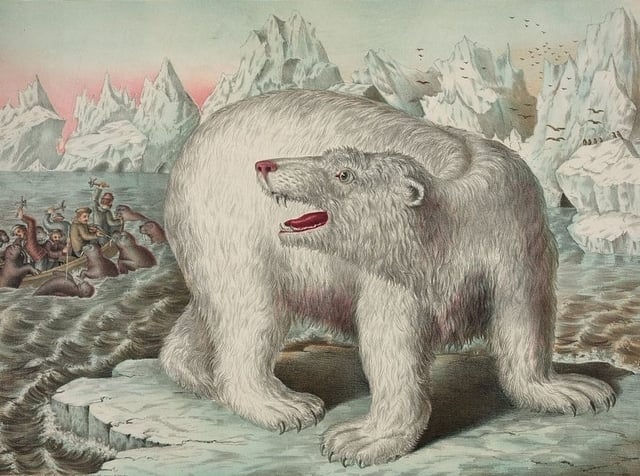 Musings upon the whys and wherefores of polar bears, particularly in relation to their forest-dwelling cousins, played an important but often overlooked role in the development of evolutionary theory. Michael Engelhard explores.
The Dreams of an Inventor in 1420
January 24, 2018
Science & Art
Musings upon the whys and wherefores of polar bears, particularly in relation to their forest-dwelling cousins, played an important but often overlooked role in the development of evolutionary theory. Michael Engelhard explores.
The Dreams of an Inventor in 1420
January 24, 2018
Science & Art
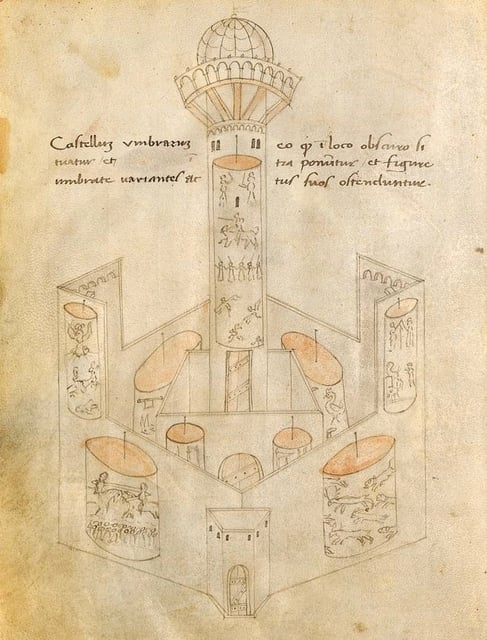 Bennett Gilbert peruses the sketchbook of 15th-century engineer Johannes de Fontana, a catalogue of designs for a variety of fantastic and often impossible inventions, including fire-breathing automatons, pulley-powered angels, and the earliest surviving drawing of a magic lantern device.
Pods, Pots, and Potions: Putting Cacao to Paper in Early Modern Europe
December 7, 2017
Science & Art & History
Bennett Gilbert peruses the sketchbook of 15th-century engineer Johannes de Fontana, a catalogue of designs for a variety of fantastic and often impossible inventions, including fire-breathing automatons, pulley-powered angels, and the earliest surviving drawing of a magic lantern device.
Pods, Pots, and Potions: Putting Cacao to Paper in Early Modern Europe
December 7, 2017
Science & Art & History
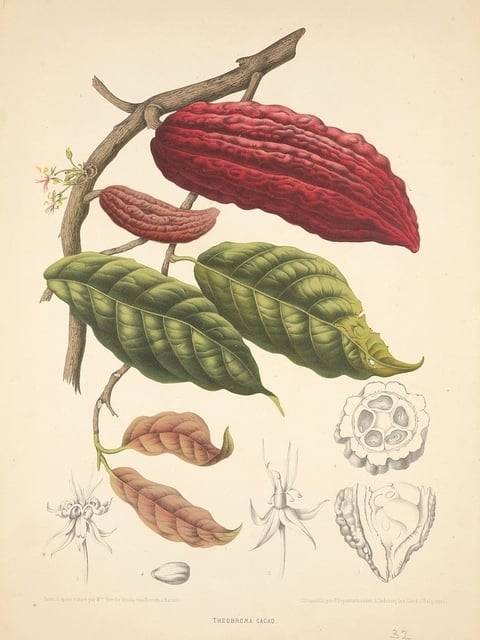 Christine Jones explores the different ways the cacao tree has been depicted through history — from 16th-century codices to 18th-century botanicals — and what this changing iconography reveals about cacao’s journey into European culture.
Master of Disaster, Ignatius Donnelly
September 27, 2017
Books & Literature & Science & Religion
Christine Jones explores the different ways the cacao tree has been depicted through history — from 16th-century codices to 18th-century botanicals — and what this changing iconography reveals about cacao’s journey into European culture.
Master of Disaster, Ignatius Donnelly
September 27, 2017
Books & Literature & Science & Religion
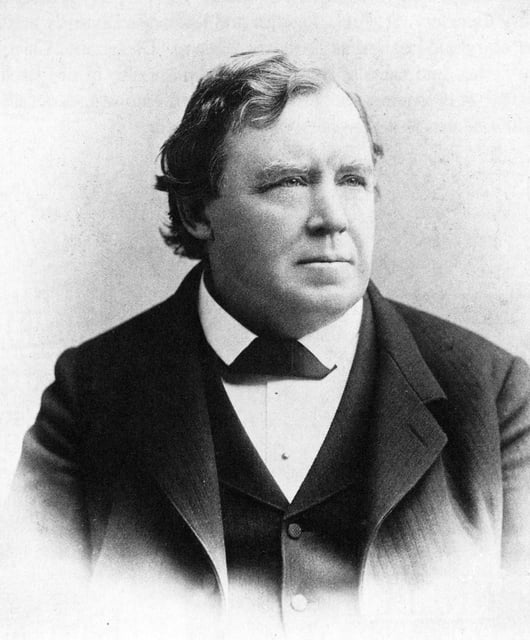 The destruction of Atlantis, cataclysmic comets, and a Manhattan tower made entirely from concrete and corpse — Carl Abbott on the life and work of a Minnesotan writer, and failed politician, with a mind primed for catastrophe.
Human Forms in Nature: Ernst Haeckel’s Trip to South Asia and Its Aftermath
September 13, 2017
Science & Art
The destruction of Atlantis, cataclysmic comets, and a Manhattan tower made entirely from concrete and corpse — Carl Abbott on the life and work of a Minnesotan writer, and failed politician, with a mind primed for catastrophe.
Human Forms in Nature: Ernst Haeckel’s Trip to South Asia and Its Aftermath
September 13, 2017
Science & Art
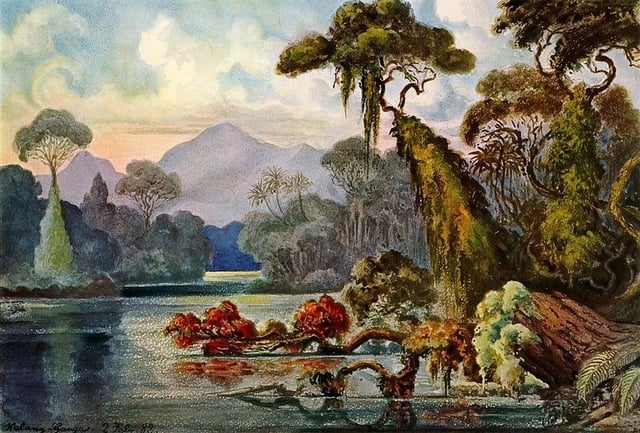 An early promoter and populariser of Darwin’s evolutionary theory, the German biologist and artist Ernst Haeckel was a hugely influential figure of the late 19th century. Bernd Brunner looks at how a trip to Sri Lanka sowed the seeds for not only Haeckel’s majestic illustrations from his Art Forms in Nature, for which he is perhaps best known today, but also his disturbing ideas on race and eugenics.
W. B. O’Shaughnessy and the Introduction of Cannabis to Modern Western Medicine
April 19, 2017
Science
An early promoter and populariser of Darwin’s evolutionary theory, the German biologist and artist Ernst Haeckel was a hugely influential figure of the late 19th century. Bernd Brunner looks at how a trip to Sri Lanka sowed the seeds for not only Haeckel’s majestic illustrations from his Art Forms in Nature, for which he is perhaps best known today, but also his disturbing ideas on race and eugenics.
W. B. O’Shaughnessy and the Introduction of Cannabis to Modern Western Medicine
April 19, 2017
Science
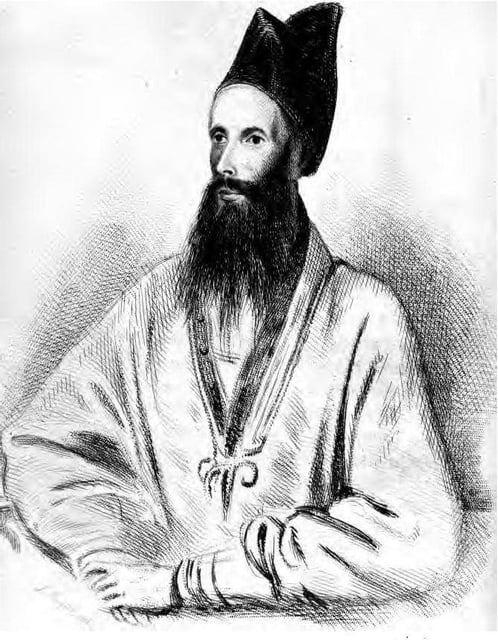 Cataleptic trances, enormous appetites, and giggling fits aside, W. B. O’Shaughnessy’s investigations at a Calcutta hospital into the potential of medical marijuana — the first such trials in modern medicine — were largely positive. Sujaan Mukherjee explores the intricacies of this pioneering research and what it can tell us more generally about the production of knowledge in colonial science.
Lofty Only in Sound: Crossed Wires and Community in 19th-Century Dreams
April 5, 2017
Poems & Science & History
Cataleptic trances, enormous appetites, and giggling fits aside, W. B. O’Shaughnessy’s investigations at a Calcutta hospital into the potential of medical marijuana — the first such trials in modern medicine — were largely positive. Sujaan Mukherjee explores the intricacies of this pioneering research and what it can tell us more generally about the production of knowledge in colonial science.
Lofty Only in Sound: Crossed Wires and Community in 19th-Century Dreams
April 5, 2017
Poems & Science & History
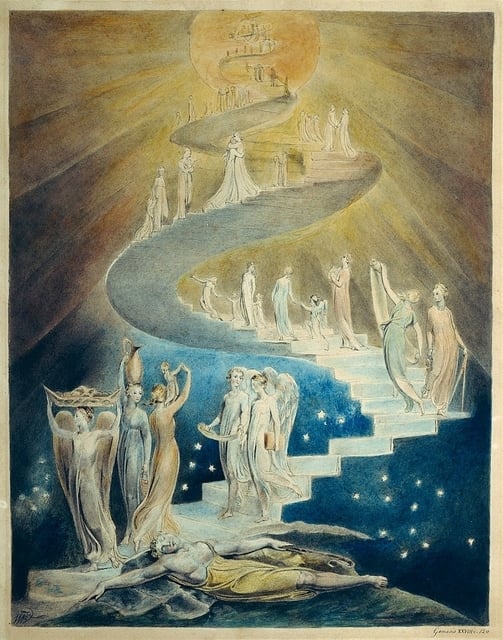 Alicia Puglionesi explores a curious case of supposed dream telepathy at the end of the US Civil War, in which old ideas about the prophetic nature of dreaming collided with loss, longing, and new possibilities of communication at a distance.
The Many Lives of the Medieval Wound Man
December 7, 2016
Science & Art
Alicia Puglionesi explores a curious case of supposed dream telepathy at the end of the US Civil War, in which old ideas about the prophetic nature of dreaming collided with loss, longing, and new possibilities of communication at a distance.
The Many Lives of the Medieval Wound Man
December 7, 2016
Science & Art
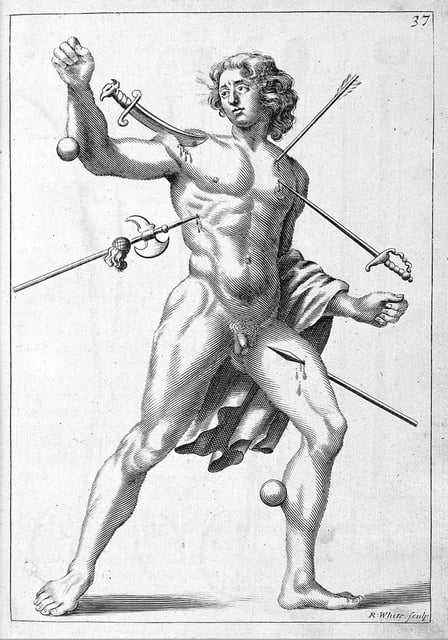 Sliced, stabbed, punctured, bleeding, harassed on all sides by various weaponry, the curious image of Wound Man is a rare yet intriguing presence in the world of medieval and early modern medical manuscripts. Jack Hartnell explores this enigmatic figure’s journey through the centuries.
“Let us Calculate!”: Leibniz, Llull, and the Computational Imagination
November 10, 2016
Science & Philosophy & History
Sliced, stabbed, punctured, bleeding, harassed on all sides by various weaponry, the curious image of Wound Man is a rare yet intriguing presence in the world of medieval and early modern medical manuscripts. Jack Hartnell explores this enigmatic figure’s journey through the centuries.
“Let us Calculate!”: Leibniz, Llull, and the Computational Imagination
November 10, 2016
Science & Philosophy & History
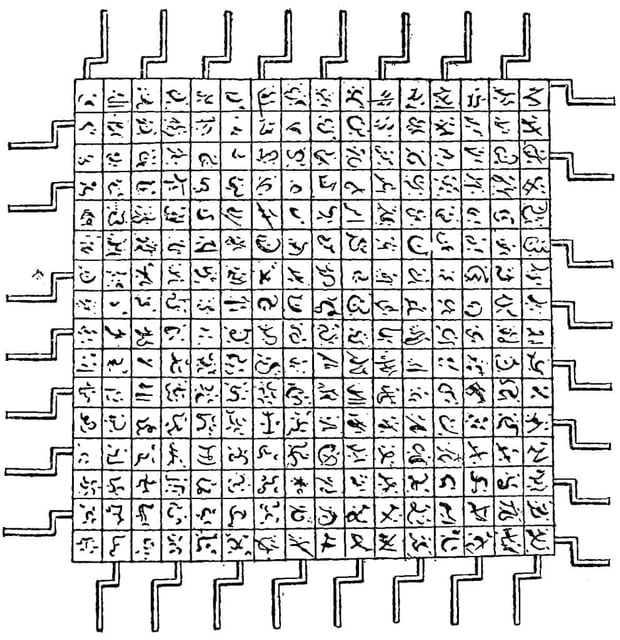 Three hundred years after the death of Gottfried Wilhelm Leibniz and seven hundred years after the death of Ramon Llull, Jonathan Gray looks at how their early visions of computation and the “combinatorial art” speak to our own age of data, algorithms, and artificial intelligence.
Visions of Algae in Eighteenth-Century Botany
September 7, 2016
Science
Three hundred years after the death of Gottfried Wilhelm Leibniz and seven hundred years after the death of Ramon Llull, Jonathan Gray looks at how their early visions of computation and the “combinatorial art” speak to our own age of data, algorithms, and artificial intelligence.
Visions of Algae in Eighteenth-Century Botany
September 7, 2016
Science
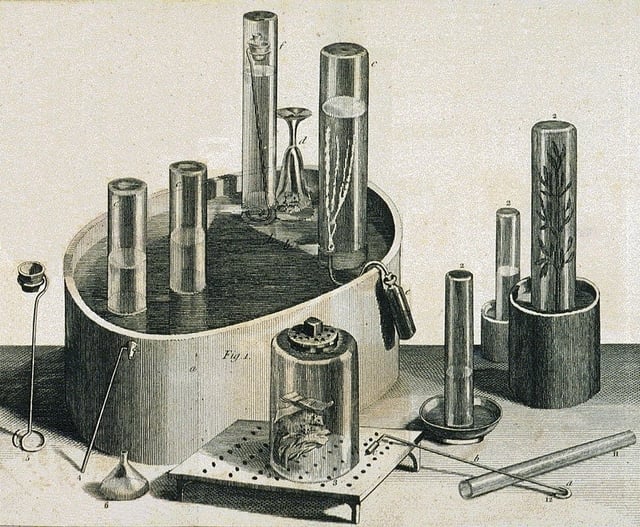 Although not normally considered the most glamorous of Mother Nature’s offerings, algae has found itself at the heart of many a key moment in the last few hundred years of botanical science. Ryan Feigenbaum traces the surprising history of one particular species — Conferva fontinalis — from the vials of Joseph Priestley’s laboratory to its possible role as inspiration for Shelley’s Frankenstein.
Copying Pictures, Evidencing Evolution
May 18, 2016
Science
Although not normally considered the most glamorous of Mother Nature’s offerings, algae has found itself at the heart of many a key moment in the last few hundred years of botanical science. Ryan Feigenbaum traces the surprising history of one particular species — Conferva fontinalis — from the vials of Joseph Priestley’s laboratory to its possible role as inspiration for Shelley’s Frankenstein.
Copying Pictures, Evidencing Evolution
May 18, 2016
Science
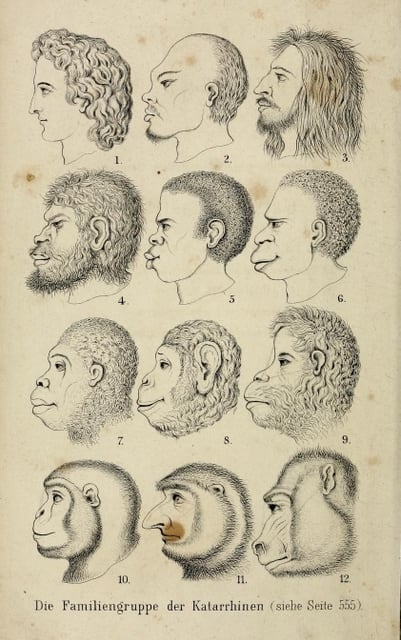 Copying — unoriginal, dull, and derivative by definition — can be creative, contested, and consequential in its effects. Nick Hopwood tracks Haeckel’s embryos, some of the most controversial pictures in the history of science, and explores how copying put them among the most widely seen.
Frolicsome Engines: The Long Prehistory of Artificial Intelligence
May 4, 2016
Science
Copying — unoriginal, dull, and derivative by definition — can be creative, contested, and consequential in its effects. Nick Hopwood tracks Haeckel’s embryos, some of the most controversial pictures in the history of science, and explores how copying put them among the most widely seen.
Frolicsome Engines: The Long Prehistory of Artificial Intelligence
May 4, 2016
Science
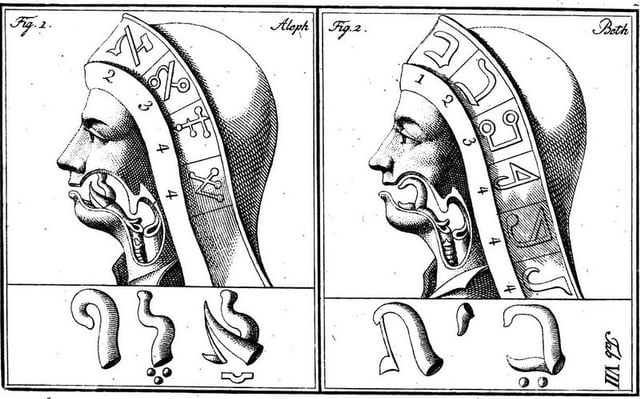 Defecating ducks, talking busts, and mechanised Christs — Jessica Riskin on the wonderful history of automata, machines built to mimic the processes of intelligent life.
The Anthropometric Detective and His Racial Clues
February 24, 2016
Science
Defecating ducks, talking busts, and mechanised Christs — Jessica Riskin on the wonderful history of automata, machines built to mimic the processes of intelligent life.
The Anthropometric Detective and His Racial Clues
February 24, 2016
Science
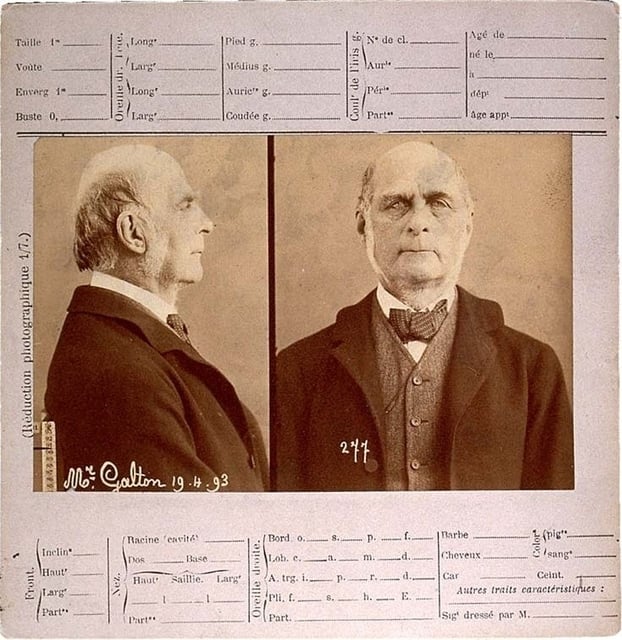 Ava Kofman explores how the spectre of race, in particular Francis Galton’s disturbing theory of eugenics, haunts the early history of fingerprint technology.
Worlds Without End
December 9, 2015
Science & Religion
Ava Kofman explores how the spectre of race, in particular Francis Galton’s disturbing theory of eugenics, haunts the early history of fingerprint technology.
Worlds Without End
December 9, 2015
Science & Religion
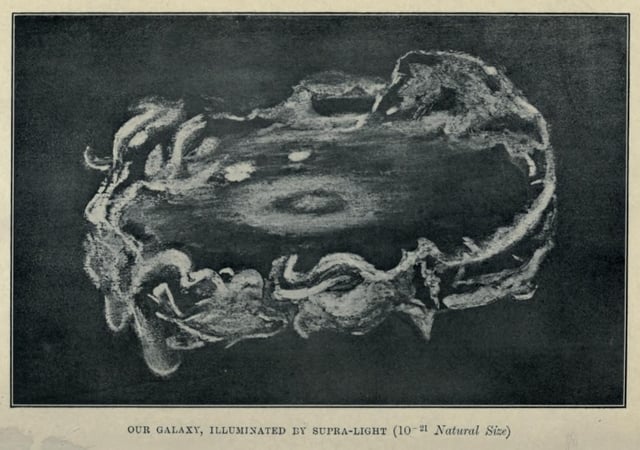 At the end of the 19th century, inspired by radical advances in technology, physicists asserted the reality of invisible worlds — an idea through which they sought to address not only psychic phenomena such as telepathy, but also spiritual questions around the soul and immortality. Philip Ball explores this fascinating history, and how in this turn to the unseen in the face of mystery there exists a parallel to quantum physics today.
The Science of Life and Death in Mary Shelley’s Frankenstein
November 25, 2015
Books & Science
Professor Sharon Ruston surveys the scientific background to Mary Shelley’s Frankenstein, considering contemporary investigations into resuscitation, galvanism, and the possibility of states between life and death.
Notes on the Fourth Dimension
October 28, 2015
Books & Science & Philosophy
At the end of the 19th century, inspired by radical advances in technology, physicists asserted the reality of invisible worlds — an idea through which they sought to address not only psychic phenomena such as telepathy, but also spiritual questions around the soul and immortality. Philip Ball explores this fascinating history, and how in this turn to the unseen in the face of mystery there exists a parallel to quantum physics today.
The Science of Life and Death in Mary Shelley’s Frankenstein
November 25, 2015
Books & Science
Professor Sharon Ruston surveys the scientific background to Mary Shelley’s Frankenstein, considering contemporary investigations into resuscitation, galvanism, and the possibility of states between life and death.
Notes on the Fourth Dimension
October 28, 2015
Books & Science & Philosophy
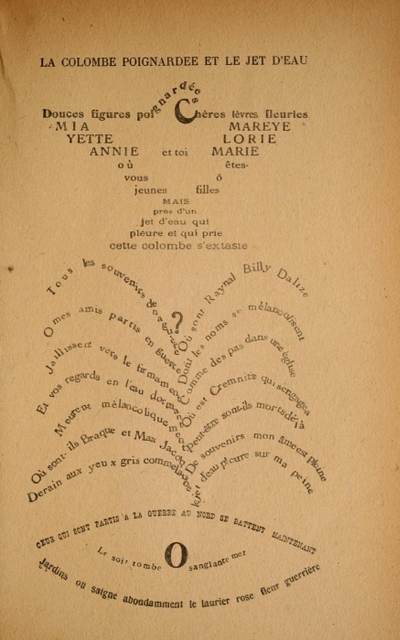 Hyperspace, ghosts, and colourful cubes — Jon Crabb on the work of Charles Howard Hinton and the cultural history of higher dimensions.
Richard Spruce and the Trials of Victorian Bryology
October 14, 2015
Science
Hyperspace, ghosts, and colourful cubes — Jon Crabb on the work of Charles Howard Hinton and the cultural history of higher dimensions.
Richard Spruce and the Trials of Victorian Bryology
October 14, 2015
Science
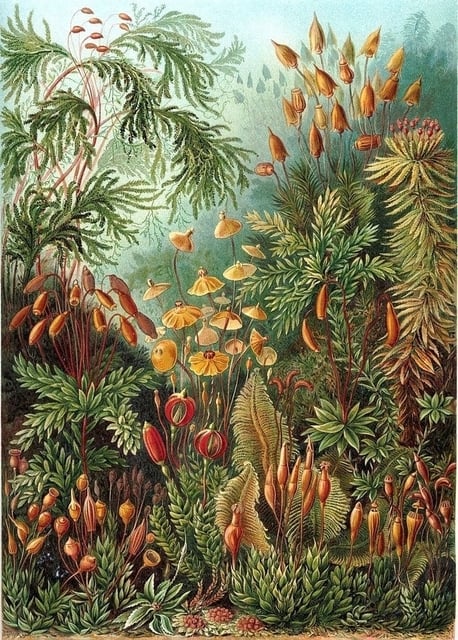 Obsessed with the smallest and seemingly least exciting of plants — mosses and liverworts — the 19th-century botanist Richard Spruce never achieved the fame of his more popularist contemporaries. Elaine Ayers explores the work of this unsung hero of Victorian plant science and how his complexities echoed the very subject of his study.
Bad Air: Pollution, Sin, and Science Fiction in William Delisle Hay’s The Doom of the Great City (1880)
September 30, 2015
Books & Literature & Science
Obsessed with the smallest and seemingly least exciting of plants — mosses and liverworts — the 19th-century botanist Richard Spruce never achieved the fame of his more popularist contemporaries. Elaine Ayers explores the work of this unsung hero of Victorian plant science and how his complexities echoed the very subject of his study.
Bad Air: Pollution, Sin, and Science Fiction in William Delisle Hay’s The Doom of the Great City (1880)
September 30, 2015
Books & Literature & Science
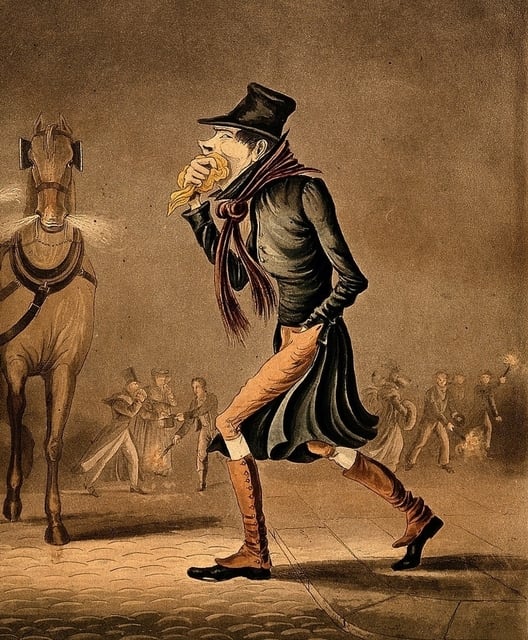 Deadly fogs, moralistic diatribes, debunked medical theory — Brett Beasley explores a piece of Victorian science fiction considered to be the first modern tale of urban apocalypse.
Dr Mitchill and the Mathematical Tetrodon
September 16, 2015
Science
Deadly fogs, moralistic diatribes, debunked medical theory — Brett Beasley explores a piece of Victorian science fiction considered to be the first modern tale of urban apocalypse.
Dr Mitchill and the Mathematical Tetrodon
September 16, 2015
Science
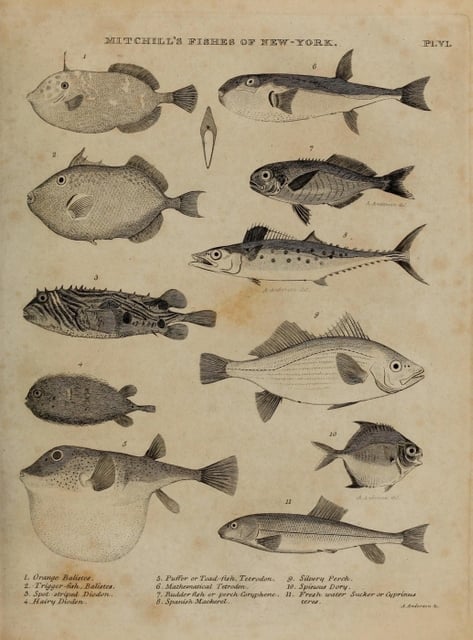 One of the early Republic’s great polymaths, New Yorker Samuel L. Mitchill was a man with a finger in many a pie, including medicine, science, natural history, and politics. Dr Kevin Dann argues that Mitchill’s peculiar brand of curiosity can best be seen in his study of fish and the attention he gives one seemingly unassuming specimen.
When the Birds and the Bees Were Not Enough: Aristotle’s Masterpiece
August 19, 2015
Books & Science
Mary Fissell on how a wildly popular sex manual — first published in 17th-century London and reprinted in hundreds of subsequent editions — both taught and titillated through the early modern period and beyond.
Cat Pianos, Sound-Houses, and Other Imaginary Musical Instruments
July 15, 2015
Music & Science & History
One of the early Republic’s great polymaths, New Yorker Samuel L. Mitchill was a man with a finger in many a pie, including medicine, science, natural history, and politics. Dr Kevin Dann argues that Mitchill’s peculiar brand of curiosity can best be seen in his study of fish and the attention he gives one seemingly unassuming specimen.
When the Birds and the Bees Were Not Enough: Aristotle’s Masterpiece
August 19, 2015
Books & Science
Mary Fissell on how a wildly popular sex manual — first published in 17th-century London and reprinted in hundreds of subsequent editions — both taught and titillated through the early modern period and beyond.
Cat Pianos, Sound-Houses, and Other Imaginary Musical Instruments
July 15, 2015
Music & Science & History
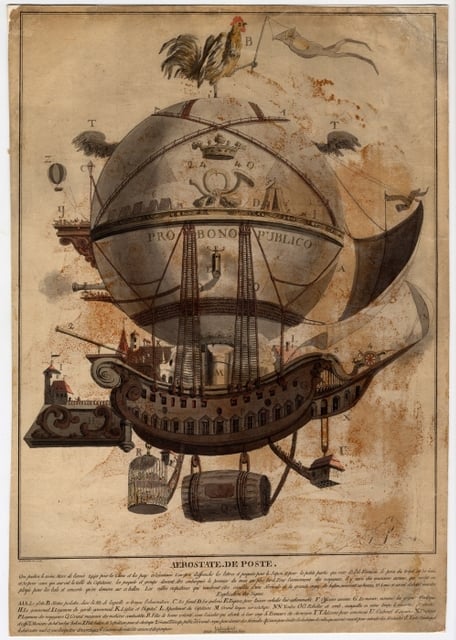 Deirdre Loughridge and Thomas Patteson, curators of the Museum of Imaginary Musical Instruments, explore the wonderful history of made-up musical contraptions, including a piano comprised of yelping cats and Francis Bacon’s 17th-century vision of experimental sound manipulation.
Black on Black
April 9, 2015
Books & Painting & Science & Philosophy
Deirdre Loughridge and Thomas Patteson, curators of the Museum of Imaginary Musical Instruments, explore the wonderful history of made-up musical contraptions, including a piano comprised of yelping cats and Francis Bacon’s 17th-century vision of experimental sound manipulation.
Black on Black
April 9, 2015
Books & Painting & Science & Philosophy
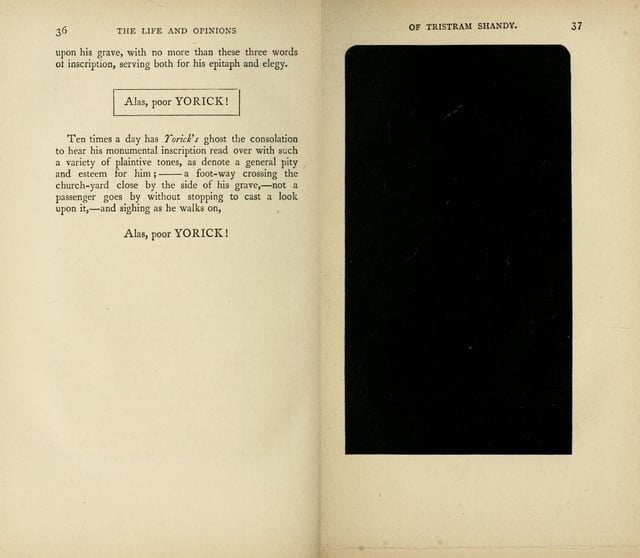 Should we consider black a colour, the absence of colour, or a suspension of vision produced by a deprivation of light? Beginning with Robert Fludd’s attempt to picture nothingness, Eugene Thacker reflects* on some of the ways in which blackness has been used and thought about through the history of art and philosophical thought.
Sex and Science in Robert Thornton’s Temple of Flora
March 11, 2015
Books & Poems & Painting & Science & Art
Should we consider black a colour, the absence of colour, or a suspension of vision produced by a deprivation of light? Beginning with Robert Fludd’s attempt to picture nothingness, Eugene Thacker reflects* on some of the ways in which blackness has been used and thought about through the history of art and philosophical thought.
Sex and Science in Robert Thornton’s Temple of Flora
March 11, 2015
Books & Poems & Painting & Science & Art
 Bridal beds, blushing captives, and swollen trunks – Carl Linnaeus’ taxonomy of plants heralded a whole new era in 18th-century Europe of plants being spoken of in sexualised terms. Martin Kemp explores* how this association between the floral and erotic reached its visual zenith in Robert Thornton’s exquisitely illustrated Temple of Flora.
Neanderthals in 3D: L’Homme de La Chapelle
February 11, 2015
Books & Photography & Science
Bridal beds, blushing captives, and swollen trunks – Carl Linnaeus’ taxonomy of plants heralded a whole new era in 18th-century Europe of plants being spoken of in sexualised terms. Martin Kemp explores* how this association between the floral and erotic reached its visual zenith in Robert Thornton’s exquisitely illustrated Temple of Flora.
Neanderthals in 3D: L’Homme de La Chapelle
February 11, 2015
Books & Photography & Science
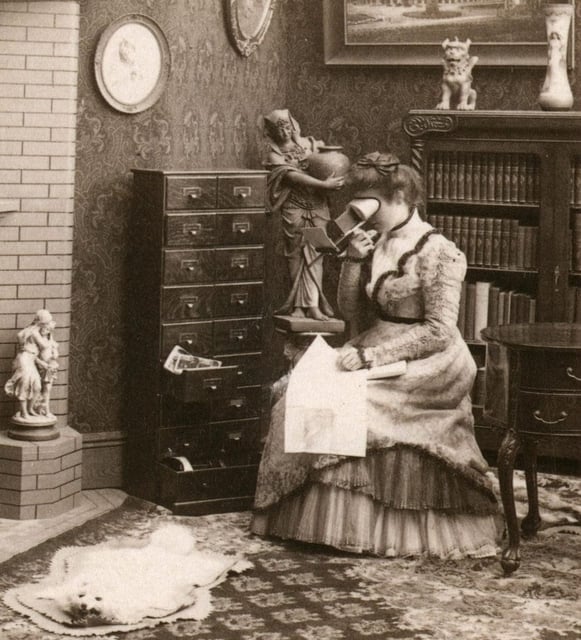 More than just a favourite of Victorian home entertainment, the stereoscope and the 3D images it created were also used in the field of science. Lydia Pyne explores how the French palaeontologist Marcellin Boule utilised the device in his groundbreaking monograph analysing one of the early-20th-century’s most significant archaeological discoveries – the Neanderthal skeleton of La Chapelle.
When Chocolate was Medicine: Colmenero, Wadsworth, and Dufour
January 28, 2015
Science & History
Chocolate has not always been the common confectionary we experience today. When it first arrived from the Americas into Europe in the 17th century it was a rare and mysterious substance, thought more of as a drug than as a food. Christine Jones traces the history and literature of its reception.
Julia Pastrana: A “Monster to the Whole World”
November 26, 2014
Science & History
More than just a favourite of Victorian home entertainment, the stereoscope and the 3D images it created were also used in the field of science. Lydia Pyne explores how the French palaeontologist Marcellin Boule utilised the device in his groundbreaking monograph analysing one of the early-20th-century’s most significant archaeological discoveries – the Neanderthal skeleton of La Chapelle.
When Chocolate was Medicine: Colmenero, Wadsworth, and Dufour
January 28, 2015
Science & History
Chocolate has not always been the common confectionary we experience today. When it first arrived from the Americas into Europe in the 17th century it was a rare and mysterious substance, thought more of as a drug than as a food. Christine Jones traces the history and literature of its reception.
Julia Pastrana: A “Monster to the Whole World”
November 26, 2014
Science & History
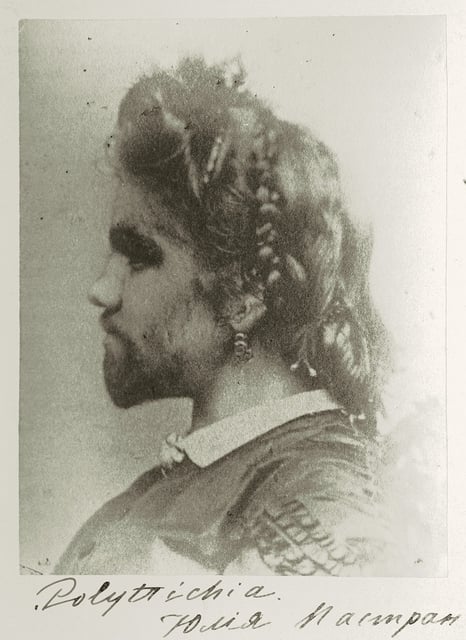 Julia Pastrana, a woman from Mexico born with hypertrichosis, became one of the most famous human curiosities of the 19th century, exhibited the world over as a “bearded lady” while both alive and dead. Bess Lovejoy explores her story and how it was only in 2013, 153 years after her passing, that she was finally laid to rest.
Illustrations of Madness: James Tilly Matthews and the Air Loom
November 12, 2014
Science & Art & History
Mike Jay recounts the tragic story of James Tilly Matthews, a former peace activist of the Napoleonic Wars who was confined to London’s notorious Bedlam asylum in 1797 for believing that his mind was under the control of the “Air Loom” – a terrifying machine whose mesmeric rays and mysterious gases were brainwashing politicians and plunging Europe into revolution, terror, and war.
Redressing the Balance: Levinus Vincent’s Wonder Theatre of Nature
August 20, 2014
Science & Art
Bert van de Roemer explores the curiosity cabinet of the Dutch collector Levinus Vincent and how the aesthetic drive behind his meticulous ordering of the contents was in essence religious, an attempt to emphasise the wonder of God’s creations by restoring the natural world to its prelapsarian harmony.
“O, Excellent Air Bag”: Humphry Davy and Nitrous Oxide
August 6, 2014
Science
Julia Pastrana, a woman from Mexico born with hypertrichosis, became one of the most famous human curiosities of the 19th century, exhibited the world over as a “bearded lady” while both alive and dead. Bess Lovejoy explores her story and how it was only in 2013, 153 years after her passing, that she was finally laid to rest.
Illustrations of Madness: James Tilly Matthews and the Air Loom
November 12, 2014
Science & Art & History
Mike Jay recounts the tragic story of James Tilly Matthews, a former peace activist of the Napoleonic Wars who was confined to London’s notorious Bedlam asylum in 1797 for believing that his mind was under the control of the “Air Loom” – a terrifying machine whose mesmeric rays and mysterious gases were brainwashing politicians and plunging Europe into revolution, terror, and war.
Redressing the Balance: Levinus Vincent’s Wonder Theatre of Nature
August 20, 2014
Science & Art
Bert van de Roemer explores the curiosity cabinet of the Dutch collector Levinus Vincent and how the aesthetic drive behind his meticulous ordering of the contents was in essence religious, an attempt to emphasise the wonder of God’s creations by restoring the natural world to its prelapsarian harmony.
“O, Excellent Air Bag”: Humphry Davy and Nitrous Oxide
August 6, 2014
Science
 The summer of 1799 saw a new fad take hold in one remarkable circle of British society: the inhalation of “Laughing Gas”. The overseer and pioneer of these experiments was a young Humphry Davy, future President of the Royal Society. Mike Jay explores how Davy’s extreme and near-fatal regime of self-experimentation with the gas not only marked a new era in the history of science but a turn toward the philosophical and literary romanticism of the century to come.
The Naturalist and the Neurologist: On Charles Darwin and James Crichton-Browne
May 28, 2014
Photography & Science
The summer of 1799 saw a new fad take hold in one remarkable circle of British society: the inhalation of “Laughing Gas”. The overseer and pioneer of these experiments was a young Humphry Davy, future President of the Royal Society. Mike Jay explores how Davy’s extreme and near-fatal regime of self-experimentation with the gas not only marked a new era in the history of science but a turn toward the philosophical and literary romanticism of the century to come.
The Naturalist and the Neurologist: On Charles Darwin and James Crichton-Browne
May 28, 2014
Photography & Science
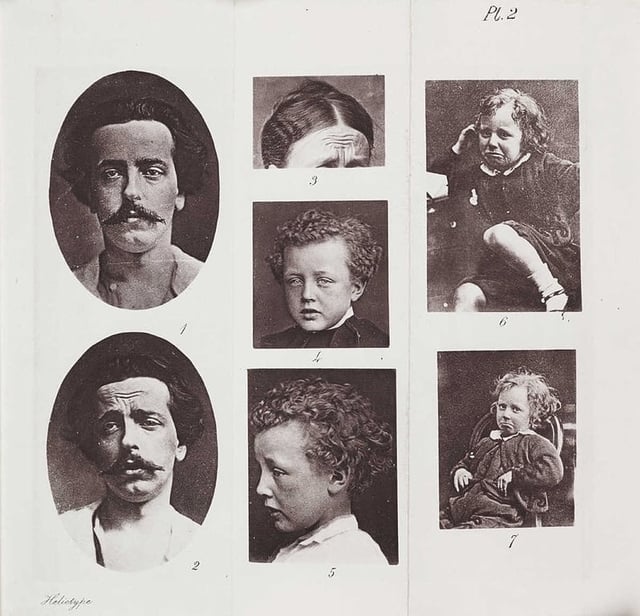 Stassa Edwards explores Charles Darwin’s photography collection, which includes almost forty portraits of mental patients given to him by the neurologist James Crichton-Browne. The study of these photographs, and the related correspondence between the two men, would prove instrumental in the development of The Expression of the Emotions in Man and Animals (1872), Darwin’s book on the evolution of emotions.
Frederik Ruysch: The Artist of Death
March 5, 2014
Science & Art
Stassa Edwards explores Charles Darwin’s photography collection, which includes almost forty portraits of mental patients given to him by the neurologist James Crichton-Browne. The study of these photographs, and the related correspondence between the two men, would prove instrumental in the development of The Expression of the Emotions in Man and Animals (1872), Darwin’s book on the evolution of emotions.
Frederik Ruysch: The Artist of Death
March 5, 2014
Science & Art
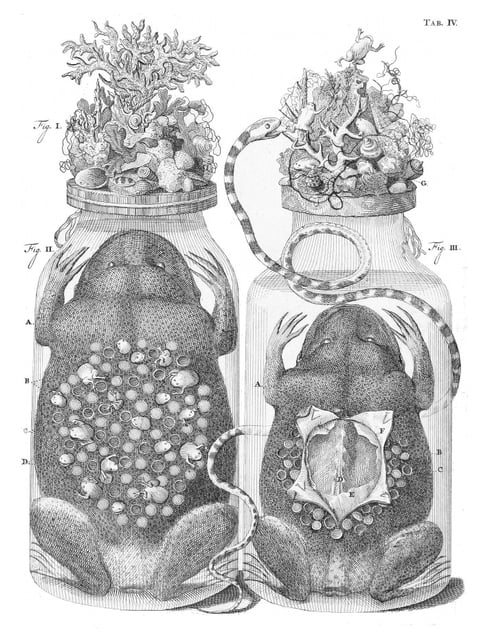 Luuc Kooijmans explores the work of Dutch anatomist Frederik Ruysch, known for his remarkable ‘still life’ displays which blurred the boundary between scientific preservation and vanitas art.
The Founding Fathers v. The Climate Change Skeptics
February 19, 2014
Science
When claims from Europe accused British America of being inferior on account of its colder weather, Thomas Jefferson and his fellow Founding Fathers responded with patriotic zeal that their settlement was actually causing the climate to warm. Raphael Calel explores how, in contrast to today’s common association of the U.S. with climate change skepticism, it was a very different story in the 18th century.
Olaus Magnus’ Sea Serpent
February 5, 2014
Painting & Science & Art
Luuc Kooijmans explores the work of Dutch anatomist Frederik Ruysch, known for his remarkable ‘still life’ displays which blurred the boundary between scientific preservation and vanitas art.
The Founding Fathers v. The Climate Change Skeptics
February 19, 2014
Science
When claims from Europe accused British America of being inferior on account of its colder weather, Thomas Jefferson and his fellow Founding Fathers responded with patriotic zeal that their settlement was actually causing the climate to warm. Raphael Calel explores how, in contrast to today’s common association of the U.S. with climate change skepticism, it was a very different story in the 18th century.
Olaus Magnus’ Sea Serpent
February 5, 2014
Painting & Science & Art
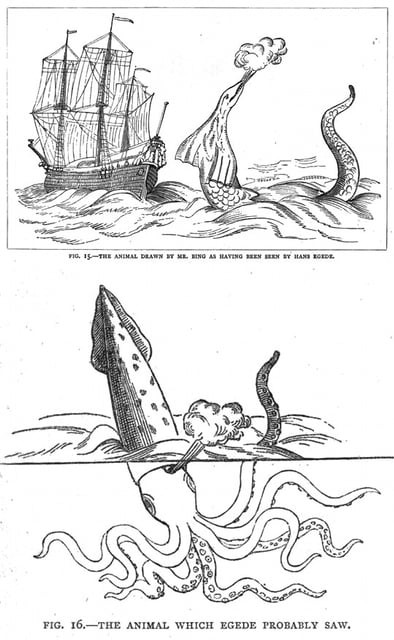 The terrifying Great Norway Serpent, or Sea Orm, is the most famous of the many influential sea monsters depicted and described by 16th-century ecclesiastic, cartographer, and historian Olaus Magnus. Joseph Nigg, author of Sea Monsters, explores the iconic and literary legacy of the controversial serpent from its beginnings in the medieval imagination to modern cryptozoology.
Writing his Life through the Other: The Anthropology of Malinowski
January 22, 2014
Science & History
Last year saw the works of Bronislaw Malinowski – father of modern anthropology – enter the public domain in many countries around the world. Michael W. Young explores the personal crisis plaguing the Polish-born anthropologist at the end of his first major stint of ethnographic immersion in the Trobriand Islands, a period of self-doubt glimpsed through entries in his diary – the most infamous, most nakedly honest document in the annals of social anthropology.
Alfred Russel Wallace: a Heretic’s Heretic
October 30, 2013
Science & Religion
The terrifying Great Norway Serpent, or Sea Orm, is the most famous of the many influential sea monsters depicted and described by 16th-century ecclesiastic, cartographer, and historian Olaus Magnus. Joseph Nigg, author of Sea Monsters, explores the iconic and literary legacy of the controversial serpent from its beginnings in the medieval imagination to modern cryptozoology.
Writing his Life through the Other: The Anthropology of Malinowski
January 22, 2014
Science & History
Last year saw the works of Bronislaw Malinowski – father of modern anthropology – enter the public domain in many countries around the world. Michael W. Young explores the personal crisis plaguing the Polish-born anthropologist at the end of his first major stint of ethnographic immersion in the Trobriand Islands, a period of self-doubt glimpsed through entries in his diary – the most infamous, most nakedly honest document in the annals of social anthropology.
Alfred Russel Wallace: a Heretic’s Heretic
October 30, 2013
Science & Religion
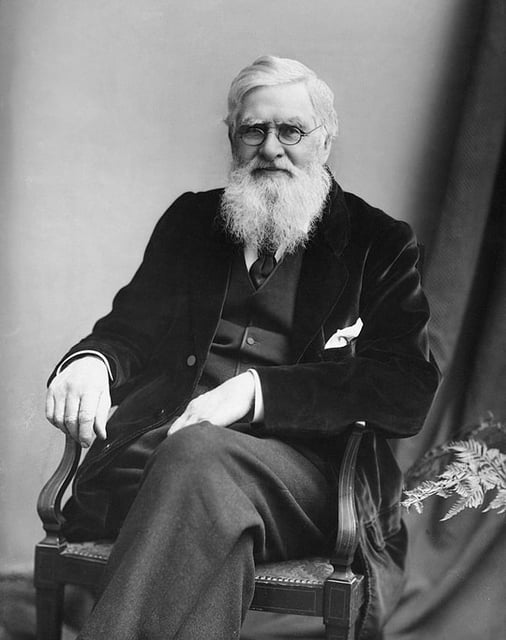 On the centenary of his death, Michael A. Flannery looks back at how Alfred Russel Wallace’s take on evolution, which radically reintroduced notions of purpose and design, still speaks to us in a post-Darwin world where problems of sentience and of the origin of life remain, some would argue, as intractable as ever.
Proving it: The American Provers’ Union documents certain ill effects
September 4, 2013
Science
What would induce physicians to ingest mercury to the point of vomiting and to painstakingly note down the effects of imbibing large amounts of cannabis tincture? Alicia Puglionesi explores the history of “proving”, the practice of auto-experimentation which forms the cornerstone of homeopathic medicine.
Re-examining ‘the Elephant Man’
July 24, 2013
Science & History
Nadja Durbach questions the extent to which Joseph Merrick, known as the Elephant Man, was exploited during his time in a Victorian ‘freakshow’, and asks if it wasn’t perhaps the medical establishment, often seen as his saviour, who really took advantage of Merrick and his condition.
As a Lute out of Tune: Robert Burton’s Melancholy
May 1, 2013
Books & Science & Philosophy
In 1621 Robert Burton first published his masterpiece The Anatomy of Melancholy, a vast feat of scholarship examining in encyclopaedic detail that most enigmatic of maladies. Noga Arikha explores the book, said to be the favorite of both Samuel Johnson and Keats, and places it within the context of the humoural theory so popular at the time.
Vesalius and the Body Metaphor
April 18, 2013
Books & Science & History
On the centenary of his death, Michael A. Flannery looks back at how Alfred Russel Wallace’s take on evolution, which radically reintroduced notions of purpose and design, still speaks to us in a post-Darwin world where problems of sentience and of the origin of life remain, some would argue, as intractable as ever.
Proving it: The American Provers’ Union documents certain ill effects
September 4, 2013
Science
What would induce physicians to ingest mercury to the point of vomiting and to painstakingly note down the effects of imbibing large amounts of cannabis tincture? Alicia Puglionesi explores the history of “proving”, the practice of auto-experimentation which forms the cornerstone of homeopathic medicine.
Re-examining ‘the Elephant Man’
July 24, 2013
Science & History
Nadja Durbach questions the extent to which Joseph Merrick, known as the Elephant Man, was exploited during his time in a Victorian ‘freakshow’, and asks if it wasn’t perhaps the medical establishment, often seen as his saviour, who really took advantage of Merrick and his condition.
As a Lute out of Tune: Robert Burton’s Melancholy
May 1, 2013
Books & Science & Philosophy
In 1621 Robert Burton first published his masterpiece The Anatomy of Melancholy, a vast feat of scholarship examining in encyclopaedic detail that most enigmatic of maladies. Noga Arikha explores the book, said to be the favorite of both Samuel Johnson and Keats, and places it within the context of the humoural theory so popular at the time.
Vesalius and the Body Metaphor
April 18, 2013
Books & Science & History
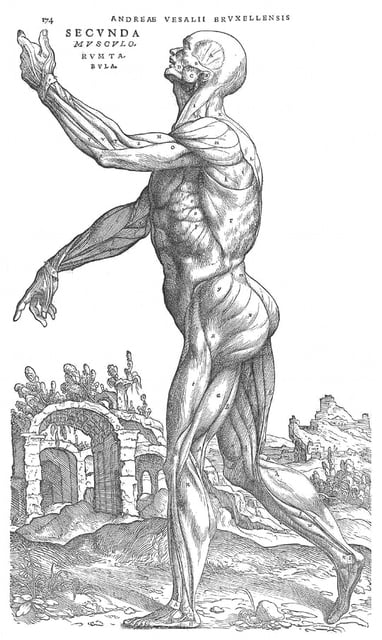 City streets, a winepress, pulleys, spinning tops, a ray fish, curdled milk: just a few of the many images used by 16th century anatomist Andreas Vesalius to explain the workings of the human body in his seminal work De Humani Corporis Fabrica. Marri Lynn explores.
Joseph Banks: Portraits of a Placid Elephant
April 4, 2013
Painting & Science & Art & History
Patricia Fara traces the changing iconography of Joseph Banks, the English botanist who travelled on Captain Cook’s first great voyage and went on to become President of the Royal Society and important patron for a whole host of significant developments in the natural sciences.
Mary Toft and Her Extraordinary Delivery of Rabbits
March 20, 2013
Science & History & Events
In late 1726 much of Britain was caught up in the curious case of Mary Toft, a woman from Surrey who claimed that she had given birth to a litter of rabbits. Niki Russell tells of the events of an elaborate 18th century hoax which had King George I’s own court physicians fooled.
Athanasius, Underground
November 1, 2012
Books & Science & Art & History
City streets, a winepress, pulleys, spinning tops, a ray fish, curdled milk: just a few of the many images used by 16th century anatomist Andreas Vesalius to explain the workings of the human body in his seminal work De Humani Corporis Fabrica. Marri Lynn explores.
Joseph Banks: Portraits of a Placid Elephant
April 4, 2013
Painting & Science & Art & History
Patricia Fara traces the changing iconography of Joseph Banks, the English botanist who travelled on Captain Cook’s first great voyage and went on to become President of the Royal Society and important patron for a whole host of significant developments in the natural sciences.
Mary Toft and Her Extraordinary Delivery of Rabbits
March 20, 2013
Science & History & Events
In late 1726 much of Britain was caught up in the curious case of Mary Toft, a woman from Surrey who claimed that she had given birth to a litter of rabbits. Niki Russell tells of the events of an elaborate 18th century hoax which had King George I’s own court physicians fooled.
Athanasius, Underground
November 1, 2012
Books & Science & Art & History
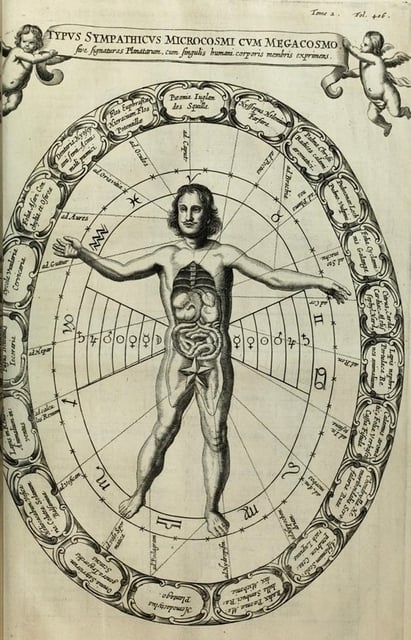 With his enormous range of scholarly pursuits the 17th-century polymath Athanasius Kircher has been hailed as the last Renaissance man and “the master of hundred arts”. John Glassie looks at one of Kircher’s great masterworks Mundus Subterraneus and how it was inspired by a subterranean adventure Kircher himself made into the bowl of Vesuvius.
The Last Great Explorer: William F. Warren and the Search for Eden
September 6, 2012
Books & Science & Philosophy & Religion
Of all the attempts throughout history to geographically locate the Garden of Eden one of the most compelling was that set out by minister and president of Boston University, William F. Warren. Brook Wilensky-Lanford looks at the ideas of the man who, in his book Paradise Found, proposed the home of all humanity to be at the North Pole.
The Krakatoa Sunsets
May 28, 2012
Poems & Literature & Science & Art & History
With his enormous range of scholarly pursuits the 17th-century polymath Athanasius Kircher has been hailed as the last Renaissance man and “the master of hundred arts”. John Glassie looks at one of Kircher’s great masterworks Mundus Subterraneus and how it was inspired by a subterranean adventure Kircher himself made into the bowl of Vesuvius.
The Last Great Explorer: William F. Warren and the Search for Eden
September 6, 2012
Books & Science & Philosophy & Religion
Of all the attempts throughout history to geographically locate the Garden of Eden one of the most compelling was that set out by minister and president of Boston University, William F. Warren. Brook Wilensky-Lanford looks at the ideas of the man who, in his book Paradise Found, proposed the home of all humanity to be at the North Pole.
The Krakatoa Sunsets
May 28, 2012
Poems & Literature & Science & Art & History
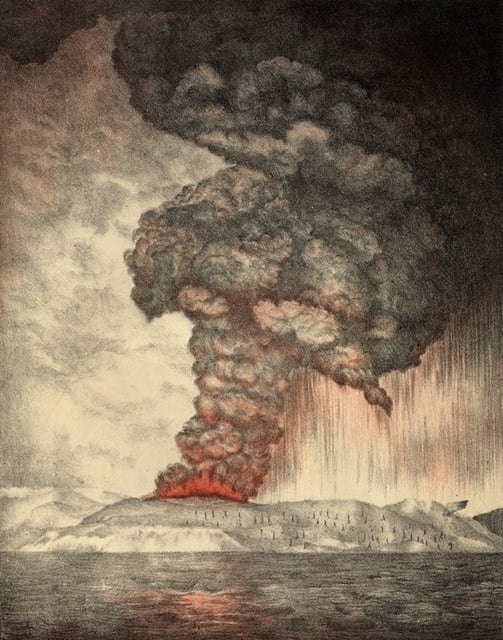 When a volcano erupted on a small island in Indonesia in 1883, the evening skies of the world glowed for months with strange colours. Richard Hamblyn explores a little-known series of letters that the poet Gerard Manley Hopkins sent in to the journal Nature describing the phenomenon – letters that would constitute the majority of the small handful of writings published while he was alive.
The Mysteries of Nature and Art
November 28, 2011
Books & Science & Art
When a volcano erupted on a small island in Indonesia in 1883, the evening skies of the world glowed for months with strange colours. Richard Hamblyn explores a little-known series of letters that the poet Gerard Manley Hopkins sent in to the journal Nature describing the phenomenon – letters that would constitute the majority of the small handful of writings published while he was alive.
The Mysteries of Nature and Art
November 28, 2011
Books & Science & Art
 Julie Gardham, Senior Assistant Librarian at University of Glasgow’s Special Collections Department, takes a look at the book that was said to have spurred a young Isaac Newton onto the scientific path, The Mysteries of Nature and Art by John Bate.
Aspiring to a Higher Plane
September 19, 2011
Books & Literature & Science & Philosophy
Julie Gardham, Senior Assistant Librarian at University of Glasgow’s Special Collections Department, takes a look at the book that was said to have spurred a young Isaac Newton onto the scientific path, The Mysteries of Nature and Art by John Bate.
Aspiring to a Higher Plane
September 19, 2011
Books & Literature & Science & Philosophy
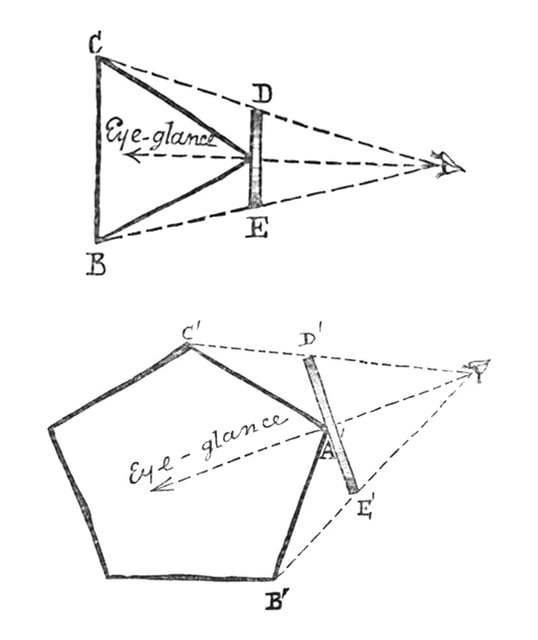 In 1884 Edwin Abbott Abbott published Flatland: A Romance of Many Dimensions, the first ever book that could be described as ‘mathematical fiction’. Ian Stewart, author of Flatterland and The Annotated Flatland, introduces the strange tale of the geometric adventures of A. Square.
Robert Fludd and His Images of The Divine
September 13, 2011
Books & Science & Philosophy & Art & Religion
In 1884 Edwin Abbott Abbott published Flatland: A Romance of Many Dimensions, the first ever book that could be described as ‘mathematical fiction’. Ian Stewart, author of Flatterland and The Annotated Flatland, introduces the strange tale of the geometric adventures of A. Square.
Robert Fludd and His Images of The Divine
September 13, 2011
Books & Science & Philosophy & Art & Religion
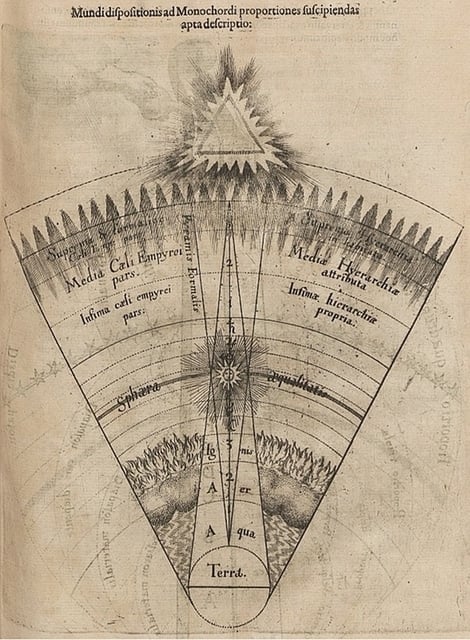 Between 1617 and 1621 the English physician and polymath Robert Fludd published his masterwork Utriusque Cosmi, a book split into two volumes and packed with over 60 intricate engravings. Urszula Szulakowska explores the philosophical and theological ideas behind the extraordinary images found in the second part of the work.
Accuracy and Elegance in Cheselden’s Osteographia (1733)
August 22, 2011
Books & Science & Art
Between 1617 and 1621 the English physician and polymath Robert Fludd published his masterwork Utriusque Cosmi, a book split into two volumes and packed with over 60 intricate engravings. Urszula Szulakowska explores the philosophical and theological ideas behind the extraordinary images found in the second part of the work.
Accuracy and Elegance in Cheselden’s Osteographia (1733)
August 22, 2011
Books & Science & Art
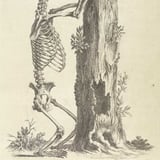 With its novel vignettes and its use of a camera obscura in the production of the plates, William Cheselden’s Osteographia, is recognized as a landmark in the history of anatomical illustration. Monique Kornell looks at its unique blend of accuracy and elegance.
American Kaleidoscope: Morton Prince and the Boston Revolution in Psychotherapy
August 5, 2011
Books & Science & Philosophy
With its novel vignettes and its use of a camera obscura in the production of the plates, William Cheselden’s Osteographia, is recognized as a landmark in the history of anatomical illustration. Monique Kornell looks at its unique blend of accuracy and elegance.
American Kaleidoscope: Morton Prince and the Boston Revolution in Psychotherapy
August 5, 2011
Books & Science & Philosophy
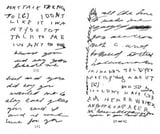 In 1906 the American physician and neurologist Morton Henry Prince published his remarkable monograph The Dissociation of a Personality in which he details the condition of ‘Sally Beauchamp’, America’s first famous multiple-personality case. George Prochnik discusses the life and thought of the man Freud called “an unimaginable ass”.
Was Charles Darwin an Atheist?
June 28, 2011
Science & History & Religion
In 1906 the American physician and neurologist Morton Henry Prince published his remarkable monograph The Dissociation of a Personality in which he details the condition of ‘Sally Beauchamp’, America’s first famous multiple-personality case. George Prochnik discusses the life and thought of the man Freud called “an unimaginable ass”.
Was Charles Darwin an Atheist?
June 28, 2011
Science & History & Religion
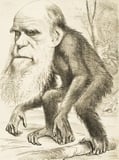 Leading Darwin expert and founder of Darwin Online, John van Wyhe, challenges the popular assumption that Darwin’s theory of evolution corresponded with a loss of religious belief.
John Muir’s Literary Science
June 9, 2011
Books & Literature & Science
Leading Darwin expert and founder of Darwin Online, John van Wyhe, challenges the popular assumption that Darwin’s theory of evolution corresponded with a loss of religious belief.
John Muir’s Literary Science
June 9, 2011
Books & Literature & Science
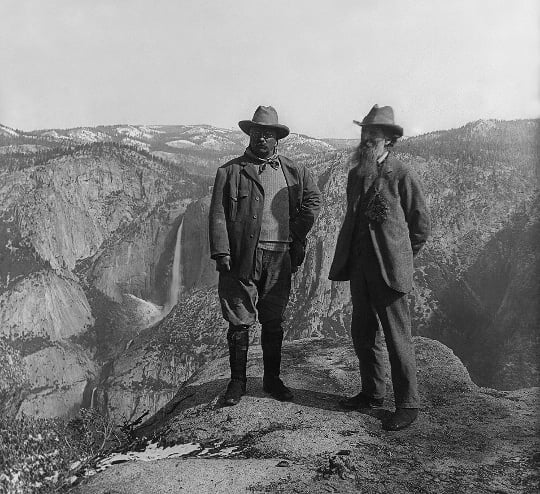 The writings of the Scottish-born American naturalist John Muir are known for their scientific acumen as well as for their rhapsodic flights. Terry Gifford, author of Reconnecting with John Muir, explores Muir’s multifaceted engagement with ‘God’s big show’.
The Life and Work of Nehemiah Grew
March 1, 2011
Books & Science & Philosophy & Art & History
The writings of the Scottish-born American naturalist John Muir are known for their scientific acumen as well as for their rhapsodic flights. Terry Gifford, author of Reconnecting with John Muir, explores Muir’s multifaceted engagement with ‘God’s big show’.
The Life and Work of Nehemiah Grew
March 1, 2011
Books & Science & Philosophy & Art & History
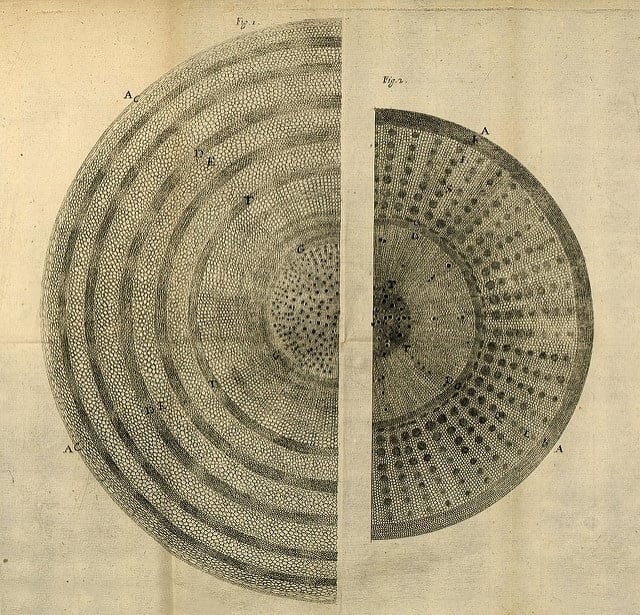 In the 82 illustrated plates included in his 1680 book The Anatomy of Plants, the English botanist Nehemiah Grew revealed for the first time the inner structure and function of plants in all their splendorous intricacy. Brian Garret explores how Grew’s pioneering “mechanist” vision in relation to the floral world paved the way for the science of plant anatomy.
The Snowflake Man of Vermont
February 14, 2011
Photography & Science & Art
In the 82 illustrated plates included in his 1680 book The Anatomy of Plants, the English botanist Nehemiah Grew revealed for the first time the inner structure and function of plants in all their splendorous intricacy. Brian Garret explores how Grew’s pioneering “mechanist” vision in relation to the floral world paved the way for the science of plant anatomy.
The Snowflake Man of Vermont
February 14, 2011
Photography & Science & Art
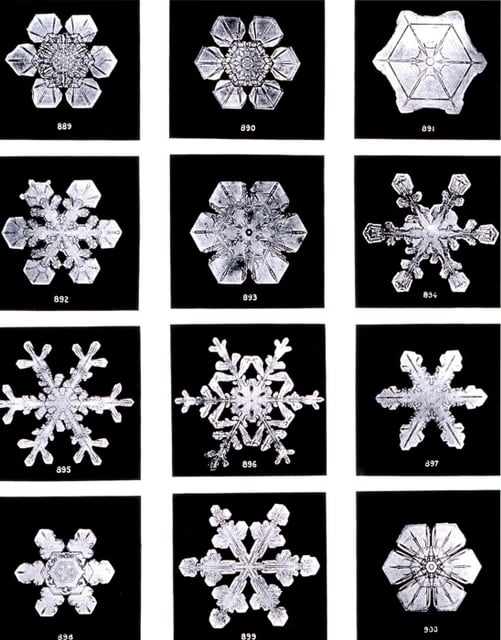 Keith C. Heidorn takes a look at the life and work of Wilson Bentley, a self-educated farmer from a small American town who, by combining a bellows camera with a microscope, managed to photograph the dizzyingly intricate and diverse structures of the snow crystal.
Ernst Haeckel and the Unity of Culture
January 24, 2011
Science & Philosophy & Art & Religion
Keith C. Heidorn takes a look at the life and work of Wilson Bentley, a self-educated farmer from a small American town who, by combining a bellows camera with a microscope, managed to photograph the dizzyingly intricate and diverse structures of the snow crystal.
Ernst Haeckel and the Unity of Culture
January 24, 2011
Science & Philosophy & Art & Religion
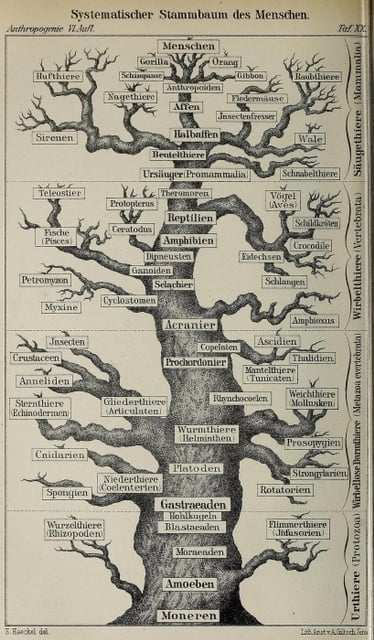 In addition to describing and naming thousands of new species the German biologist and philosopher Ernst Haeckel was behind some of history’s most impressive meetings of science and art. Dr Mario A. Di Gregorio explores Haeckel’s unique idea of “monism” which lies behind the mesmerising illustrations of his most famous work, Kunstformen Der Natur.
In addition to describing and naming thousands of new species the German biologist and philosopher Ernst Haeckel was behind some of history’s most impressive meetings of science and art. Dr Mario A. Di Gregorio explores Haeckel’s unique idea of “monism” which lies behind the mesmerising illustrations of his most famous work, Kunstformen Der Natur.
 Musings upon the whys and wherefores of polar bears, particularly in relation to their forest-dwelling cousins, played an important but often overlooked role in the development of evolutionary theory. Michael Engelhard explores.
The Dreams of an Inventor in 1420
January 24, 2018
Science & Art
Musings upon the whys and wherefores of polar bears, particularly in relation to their forest-dwelling cousins, played an important but often overlooked role in the development of evolutionary theory. Michael Engelhard explores.
The Dreams of an Inventor in 1420
January 24, 2018
Science & Art
 Bennett Gilbert peruses the sketchbook of 15th-century engineer Johannes de Fontana, a catalogue of designs for a variety of fantastic and often impossible inventions, including fire-breathing automatons, pulley-powered angels, and the earliest surviving drawing of a magic lantern device.
Pods, Pots, and Potions: Putting Cacao to Paper in Early Modern Europe
December 7, 2017
Science & Art & History
Bennett Gilbert peruses the sketchbook of 15th-century engineer Johannes de Fontana, a catalogue of designs for a variety of fantastic and often impossible inventions, including fire-breathing automatons, pulley-powered angels, and the earliest surviving drawing of a magic lantern device.
Pods, Pots, and Potions: Putting Cacao to Paper in Early Modern Europe
December 7, 2017
Science & Art & History
 Christine Jones explores the different ways the cacao tree has been depicted through history — from 16th-century codices to 18th-century botanicals — and what this changing iconography reveals about cacao’s journey into European culture.
Master of Disaster, Ignatius Donnelly
September 27, 2017
Books & Literature & Science & Religion
Christine Jones explores the different ways the cacao tree has been depicted through history — from 16th-century codices to 18th-century botanicals — and what this changing iconography reveals about cacao’s journey into European culture.
Master of Disaster, Ignatius Donnelly
September 27, 2017
Books & Literature & Science & Religion
 The destruction of Atlantis, cataclysmic comets, and a Manhattan tower made entirely from concrete and corpse — Carl Abbott on the life and work of a Minnesotan writer, and failed politician, with a mind primed for catastrophe.
Human Forms in Nature: Ernst Haeckel’s Trip to South Asia and Its Aftermath
September 13, 2017
Science & Art
The destruction of Atlantis, cataclysmic comets, and a Manhattan tower made entirely from concrete and corpse — Carl Abbott on the life and work of a Minnesotan writer, and failed politician, with a mind primed for catastrophe.
Human Forms in Nature: Ernst Haeckel’s Trip to South Asia and Its Aftermath
September 13, 2017
Science & Art
 An early promoter and populariser of Darwin’s evolutionary theory, the German biologist and artist Ernst Haeckel was a hugely influential figure of the late 19th century. Bernd Brunner looks at how a trip to Sri Lanka sowed the seeds for not only Haeckel’s majestic illustrations from his Art Forms in Nature, for which he is perhaps best known today, but also his disturbing ideas on race and eugenics.
W. B. O’Shaughnessy and the Introduction of Cannabis to Modern Western Medicine
April 19, 2017
Science
An early promoter and populariser of Darwin’s evolutionary theory, the German biologist and artist Ernst Haeckel was a hugely influential figure of the late 19th century. Bernd Brunner looks at how a trip to Sri Lanka sowed the seeds for not only Haeckel’s majestic illustrations from his Art Forms in Nature, for which he is perhaps best known today, but also his disturbing ideas on race and eugenics.
W. B. O’Shaughnessy and the Introduction of Cannabis to Modern Western Medicine
April 19, 2017
Science
 Cataleptic trances, enormous appetites, and giggling fits aside, W. B. O’Shaughnessy’s investigations at a Calcutta hospital into the potential of medical marijuana — the first such trials in modern medicine — were largely positive. Sujaan Mukherjee explores the intricacies of this pioneering research and what it can tell us more generally about the production of knowledge in colonial science.
Lofty Only in Sound: Crossed Wires and Community in 19th-Century Dreams
April 5, 2017
Poems & Science & History
Cataleptic trances, enormous appetites, and giggling fits aside, W. B. O’Shaughnessy’s investigations at a Calcutta hospital into the potential of medical marijuana — the first such trials in modern medicine — were largely positive. Sujaan Mukherjee explores the intricacies of this pioneering research and what it can tell us more generally about the production of knowledge in colonial science.
Lofty Only in Sound: Crossed Wires and Community in 19th-Century Dreams
April 5, 2017
Poems & Science & History
 Alicia Puglionesi explores a curious case of supposed dream telepathy at the end of the US Civil War, in which old ideas about the prophetic nature of dreaming collided with loss, longing, and new possibilities of communication at a distance.
The Many Lives of the Medieval Wound Man
December 7, 2016
Science & Art
Alicia Puglionesi explores a curious case of supposed dream telepathy at the end of the US Civil War, in which old ideas about the prophetic nature of dreaming collided with loss, longing, and new possibilities of communication at a distance.
The Many Lives of the Medieval Wound Man
December 7, 2016
Science & Art
 Sliced, stabbed, punctured, bleeding, harassed on all sides by various weaponry, the curious image of Wound Man is a rare yet intriguing presence in the world of medieval and early modern medical manuscripts. Jack Hartnell explores this enigmatic figure’s journey through the centuries.
“Let us Calculate!”: Leibniz, Llull, and the Computational Imagination
November 10, 2016
Science & Philosophy & History
Sliced, stabbed, punctured, bleeding, harassed on all sides by various weaponry, the curious image of Wound Man is a rare yet intriguing presence in the world of medieval and early modern medical manuscripts. Jack Hartnell explores this enigmatic figure’s journey through the centuries.
“Let us Calculate!”: Leibniz, Llull, and the Computational Imagination
November 10, 2016
Science & Philosophy & History
 Three hundred years after the death of Gottfried Wilhelm Leibniz and seven hundred years after the death of Ramon Llull, Jonathan Gray looks at how their early visions of computation and the “combinatorial art” speak to our own age of data, algorithms, and artificial intelligence.
Visions of Algae in Eighteenth-Century Botany
September 7, 2016
Science
Three hundred years after the death of Gottfried Wilhelm Leibniz and seven hundred years after the death of Ramon Llull, Jonathan Gray looks at how their early visions of computation and the “combinatorial art” speak to our own age of data, algorithms, and artificial intelligence.
Visions of Algae in Eighteenth-Century Botany
September 7, 2016
Science
 Although not normally considered the most glamorous of Mother Nature’s offerings, algae has found itself at the heart of many a key moment in the last few hundred years of botanical science. Ryan Feigenbaum traces the surprising history of one particular species — Conferva fontinalis — from the vials of Joseph Priestley’s laboratory to its possible role as inspiration for Shelley’s Frankenstein.
Copying Pictures, Evidencing Evolution
May 18, 2016
Science
Although not normally considered the most glamorous of Mother Nature’s offerings, algae has found itself at the heart of many a key moment in the last few hundred years of botanical science. Ryan Feigenbaum traces the surprising history of one particular species — Conferva fontinalis — from the vials of Joseph Priestley’s laboratory to its possible role as inspiration for Shelley’s Frankenstein.
Copying Pictures, Evidencing Evolution
May 18, 2016
Science
 Copying — unoriginal, dull, and derivative by definition — can be creative, contested, and consequential in its effects. Nick Hopwood tracks Haeckel’s embryos, some of the most controversial pictures in the history of science, and explores how copying put them among the most widely seen.
Frolicsome Engines: The Long Prehistory of Artificial Intelligence
May 4, 2016
Science
Copying — unoriginal, dull, and derivative by definition — can be creative, contested, and consequential in its effects. Nick Hopwood tracks Haeckel’s embryos, some of the most controversial pictures in the history of science, and explores how copying put them among the most widely seen.
Frolicsome Engines: The Long Prehistory of Artificial Intelligence
May 4, 2016
Science
 Defecating ducks, talking busts, and mechanised Christs — Jessica Riskin on the wonderful history of automata, machines built to mimic the processes of intelligent life.
The Anthropometric Detective and His Racial Clues
February 24, 2016
Science
Defecating ducks, talking busts, and mechanised Christs — Jessica Riskin on the wonderful history of automata, machines built to mimic the processes of intelligent life.
The Anthropometric Detective and His Racial Clues
February 24, 2016
Science
 Ava Kofman explores how the spectre of race, in particular Francis Galton’s disturbing theory of eugenics, haunts the early history of fingerprint technology.
Worlds Without End
December 9, 2015
Science & Religion
Ava Kofman explores how the spectre of race, in particular Francis Galton’s disturbing theory of eugenics, haunts the early history of fingerprint technology.
Worlds Without End
December 9, 2015
Science & Religion
 At the end of the 19th century, inspired by radical advances in technology, physicists asserted the reality of invisible worlds — an idea through which they sought to address not only psychic phenomena such as telepathy, but also spiritual questions around the soul and immortality. Philip Ball explores this fascinating history, and how in this turn to the unseen in the face of mystery there exists a parallel to quantum physics today.
The Science of Life and Death in Mary Shelley’s Frankenstein
November 25, 2015
Books & Science
Professor Sharon Ruston surveys the scientific background to Mary Shelley’s Frankenstein, considering contemporary investigations into resuscitation, galvanism, and the possibility of states between life and death.
Notes on the Fourth Dimension
October 28, 2015
Books & Science & Philosophy
At the end of the 19th century, inspired by radical advances in technology, physicists asserted the reality of invisible worlds — an idea through which they sought to address not only psychic phenomena such as telepathy, but also spiritual questions around the soul and immortality. Philip Ball explores this fascinating history, and how in this turn to the unseen in the face of mystery there exists a parallel to quantum physics today.
The Science of Life and Death in Mary Shelley’s Frankenstein
November 25, 2015
Books & Science
Professor Sharon Ruston surveys the scientific background to Mary Shelley’s Frankenstein, considering contemporary investigations into resuscitation, galvanism, and the possibility of states between life and death.
Notes on the Fourth Dimension
October 28, 2015
Books & Science & Philosophy
 Hyperspace, ghosts, and colourful cubes — Jon Crabb on the work of Charles Howard Hinton and the cultural history of higher dimensions.
Richard Spruce and the Trials of Victorian Bryology
October 14, 2015
Science
Hyperspace, ghosts, and colourful cubes — Jon Crabb on the work of Charles Howard Hinton and the cultural history of higher dimensions.
Richard Spruce and the Trials of Victorian Bryology
October 14, 2015
Science
 Obsessed with the smallest and seemingly least exciting of plants — mosses and liverworts — the 19th-century botanist Richard Spruce never achieved the fame of his more popularist contemporaries. Elaine Ayers explores the work of this unsung hero of Victorian plant science and how his complexities echoed the very subject of his study.
Bad Air: Pollution, Sin, and Science Fiction in William Delisle Hay’s The Doom of the Great City (1880)
September 30, 2015
Books & Literature & Science
Obsessed with the smallest and seemingly least exciting of plants — mosses and liverworts — the 19th-century botanist Richard Spruce never achieved the fame of his more popularist contemporaries. Elaine Ayers explores the work of this unsung hero of Victorian plant science and how his complexities echoed the very subject of his study.
Bad Air: Pollution, Sin, and Science Fiction in William Delisle Hay’s The Doom of the Great City (1880)
September 30, 2015
Books & Literature & Science
 Deadly fogs, moralistic diatribes, debunked medical theory — Brett Beasley explores a piece of Victorian science fiction considered to be the first modern tale of urban apocalypse.
Dr Mitchill and the Mathematical Tetrodon
September 16, 2015
Science
Deadly fogs, moralistic diatribes, debunked medical theory — Brett Beasley explores a piece of Victorian science fiction considered to be the first modern tale of urban apocalypse.
Dr Mitchill and the Mathematical Tetrodon
September 16, 2015
Science
 One of the early Republic’s great polymaths, New Yorker Samuel L. Mitchill was a man with a finger in many a pie, including medicine, science, natural history, and politics. Dr Kevin Dann argues that Mitchill’s peculiar brand of curiosity can best be seen in his study of fish and the attention he gives one seemingly unassuming specimen.
When the Birds and the Bees Were Not Enough: Aristotle’s Masterpiece
August 19, 2015
Books & Science
Mary Fissell on how a wildly popular sex manual — first published in 17th-century London and reprinted in hundreds of subsequent editions — both taught and titillated through the early modern period and beyond.
Cat Pianos, Sound-Houses, and Other Imaginary Musical Instruments
July 15, 2015
Music & Science & History
One of the early Republic’s great polymaths, New Yorker Samuel L. Mitchill was a man with a finger in many a pie, including medicine, science, natural history, and politics. Dr Kevin Dann argues that Mitchill’s peculiar brand of curiosity can best be seen in his study of fish and the attention he gives one seemingly unassuming specimen.
When the Birds and the Bees Were Not Enough: Aristotle’s Masterpiece
August 19, 2015
Books & Science
Mary Fissell on how a wildly popular sex manual — first published in 17th-century London and reprinted in hundreds of subsequent editions — both taught and titillated through the early modern period and beyond.
Cat Pianos, Sound-Houses, and Other Imaginary Musical Instruments
July 15, 2015
Music & Science & History
 Deirdre Loughridge and Thomas Patteson, curators of the Museum of Imaginary Musical Instruments, explore the wonderful history of made-up musical contraptions, including a piano comprised of yelping cats and Francis Bacon’s 17th-century vision of experimental sound manipulation.
Black on Black
April 9, 2015
Books & Painting & Science & Philosophy
Deirdre Loughridge and Thomas Patteson, curators of the Museum of Imaginary Musical Instruments, explore the wonderful history of made-up musical contraptions, including a piano comprised of yelping cats and Francis Bacon’s 17th-century vision of experimental sound manipulation.
Black on Black
April 9, 2015
Books & Painting & Science & Philosophy
 Should we consider black a colour, the absence of colour, or a suspension of vision produced by a deprivation of light? Beginning with Robert Fludd’s attempt to picture nothingness, Eugene Thacker reflects* on some of the ways in which blackness has been used and thought about through the history of art and philosophical thought.
Sex and Science in Robert Thornton’s Temple of Flora
March 11, 2015
Books & Poems & Painting & Science & Art
Should we consider black a colour, the absence of colour, or a suspension of vision produced by a deprivation of light? Beginning with Robert Fludd’s attempt to picture nothingness, Eugene Thacker reflects* on some of the ways in which blackness has been used and thought about through the history of art and philosophical thought.
Sex and Science in Robert Thornton’s Temple of Flora
March 11, 2015
Books & Poems & Painting & Science & Art
 Bridal beds, blushing captives, and swollen trunks – Carl Linnaeus’ taxonomy of plants heralded a whole new era in 18th-century Europe of plants being spoken of in sexualised terms. Martin Kemp explores* how this association between the floral and erotic reached its visual zenith in Robert Thornton’s exquisitely illustrated Temple of Flora.
Neanderthals in 3D: L’Homme de La Chapelle
February 11, 2015
Books & Photography & Science
Bridal beds, blushing captives, and swollen trunks – Carl Linnaeus’ taxonomy of plants heralded a whole new era in 18th-century Europe of plants being spoken of in sexualised terms. Martin Kemp explores* how this association between the floral and erotic reached its visual zenith in Robert Thornton’s exquisitely illustrated Temple of Flora.
Neanderthals in 3D: L’Homme de La Chapelle
February 11, 2015
Books & Photography & Science
 More than just a favourite of Victorian home entertainment, the stereoscope and the 3D images it created were also used in the field of science. Lydia Pyne explores how the French palaeontologist Marcellin Boule utilised the device in his groundbreaking monograph analysing one of the early-20th-century’s most significant archaeological discoveries – the Neanderthal skeleton of La Chapelle.
When Chocolate was Medicine: Colmenero, Wadsworth, and Dufour
January 28, 2015
Science & History
Chocolate has not always been the common confectionary we experience today. When it first arrived from the Americas into Europe in the 17th century it was a rare and mysterious substance, thought more of as a drug than as a food. Christine Jones traces the history and literature of its reception.
Julia Pastrana: A “Monster to the Whole World”
November 26, 2014
Science & History
More than just a favourite of Victorian home entertainment, the stereoscope and the 3D images it created were also used in the field of science. Lydia Pyne explores how the French palaeontologist Marcellin Boule utilised the device in his groundbreaking monograph analysing one of the early-20th-century’s most significant archaeological discoveries – the Neanderthal skeleton of La Chapelle.
When Chocolate was Medicine: Colmenero, Wadsworth, and Dufour
January 28, 2015
Science & History
Chocolate has not always been the common confectionary we experience today. When it first arrived from the Americas into Europe in the 17th century it was a rare and mysterious substance, thought more of as a drug than as a food. Christine Jones traces the history and literature of its reception.
Julia Pastrana: A “Monster to the Whole World”
November 26, 2014
Science & History
 Julia Pastrana, a woman from Mexico born with hypertrichosis, became one of the most famous human curiosities of the 19th century, exhibited the world over as a “bearded lady” while both alive and dead. Bess Lovejoy explores her story and how it was only in 2013, 153 years after her passing, that she was finally laid to rest.
Illustrations of Madness: James Tilly Matthews and the Air Loom
November 12, 2014
Science & Art & History
Mike Jay recounts the tragic story of James Tilly Matthews, a former peace activist of the Napoleonic Wars who was confined to London’s notorious Bedlam asylum in 1797 for believing that his mind was under the control of the “Air Loom” – a terrifying machine whose mesmeric rays and mysterious gases were brainwashing politicians and plunging Europe into revolution, terror, and war.
Redressing the Balance: Levinus Vincent’s Wonder Theatre of Nature
August 20, 2014
Science & Art
Bert van de Roemer explores the curiosity cabinet of the Dutch collector Levinus Vincent and how the aesthetic drive behind his meticulous ordering of the contents was in essence religious, an attempt to emphasise the wonder of God’s creations by restoring the natural world to its prelapsarian harmony.
“O, Excellent Air Bag”: Humphry Davy and Nitrous Oxide
August 6, 2014
Science
Julia Pastrana, a woman from Mexico born with hypertrichosis, became one of the most famous human curiosities of the 19th century, exhibited the world over as a “bearded lady” while both alive and dead. Bess Lovejoy explores her story and how it was only in 2013, 153 years after her passing, that she was finally laid to rest.
Illustrations of Madness: James Tilly Matthews and the Air Loom
November 12, 2014
Science & Art & History
Mike Jay recounts the tragic story of James Tilly Matthews, a former peace activist of the Napoleonic Wars who was confined to London’s notorious Bedlam asylum in 1797 for believing that his mind was under the control of the “Air Loom” – a terrifying machine whose mesmeric rays and mysterious gases were brainwashing politicians and plunging Europe into revolution, terror, and war.
Redressing the Balance: Levinus Vincent’s Wonder Theatre of Nature
August 20, 2014
Science & Art
Bert van de Roemer explores the curiosity cabinet of the Dutch collector Levinus Vincent and how the aesthetic drive behind his meticulous ordering of the contents was in essence religious, an attempt to emphasise the wonder of God’s creations by restoring the natural world to its prelapsarian harmony.
“O, Excellent Air Bag”: Humphry Davy and Nitrous Oxide
August 6, 2014
Science
 The summer of 1799 saw a new fad take hold in one remarkable circle of British society: the inhalation of “Laughing Gas”. The overseer and pioneer of these experiments was a young Humphry Davy, future President of the Royal Society. Mike Jay explores how Davy’s extreme and near-fatal regime of self-experimentation with the gas not only marked a new era in the history of science but a turn toward the philosophical and literary romanticism of the century to come.
The Naturalist and the Neurologist: On Charles Darwin and James Crichton-Browne
May 28, 2014
Photography & Science
The summer of 1799 saw a new fad take hold in one remarkable circle of British society: the inhalation of “Laughing Gas”. The overseer and pioneer of these experiments was a young Humphry Davy, future President of the Royal Society. Mike Jay explores how Davy’s extreme and near-fatal regime of self-experimentation with the gas not only marked a new era in the history of science but a turn toward the philosophical and literary romanticism of the century to come.
The Naturalist and the Neurologist: On Charles Darwin and James Crichton-Browne
May 28, 2014
Photography & Science
 Stassa Edwards explores Charles Darwin’s photography collection, which includes almost forty portraits of mental patients given to him by the neurologist James Crichton-Browne. The study of these photographs, and the related correspondence between the two men, would prove instrumental in the development of The Expression of the Emotions in Man and Animals (1872), Darwin’s book on the evolution of emotions.
Frederik Ruysch: The Artist of Death
March 5, 2014
Science & Art
Stassa Edwards explores Charles Darwin’s photography collection, which includes almost forty portraits of mental patients given to him by the neurologist James Crichton-Browne. The study of these photographs, and the related correspondence between the two men, would prove instrumental in the development of The Expression of the Emotions in Man and Animals (1872), Darwin’s book on the evolution of emotions.
Frederik Ruysch: The Artist of Death
March 5, 2014
Science & Art
 Luuc Kooijmans explores the work of Dutch anatomist Frederik Ruysch, known for his remarkable ‘still life’ displays which blurred the boundary between scientific preservation and vanitas art.
The Founding Fathers v. The Climate Change Skeptics
February 19, 2014
Science
When claims from Europe accused British America of being inferior on account of its colder weather, Thomas Jefferson and his fellow Founding Fathers responded with patriotic zeal that their settlement was actually causing the climate to warm. Raphael Calel explores how, in contrast to today’s common association of the U.S. with climate change skepticism, it was a very different story in the 18th century.
Olaus Magnus’ Sea Serpent
February 5, 2014
Painting & Science & Art
Luuc Kooijmans explores the work of Dutch anatomist Frederik Ruysch, known for his remarkable ‘still life’ displays which blurred the boundary between scientific preservation and vanitas art.
The Founding Fathers v. The Climate Change Skeptics
February 19, 2014
Science
When claims from Europe accused British America of being inferior on account of its colder weather, Thomas Jefferson and his fellow Founding Fathers responded with patriotic zeal that their settlement was actually causing the climate to warm. Raphael Calel explores how, in contrast to today’s common association of the U.S. with climate change skepticism, it was a very different story in the 18th century.
Olaus Magnus’ Sea Serpent
February 5, 2014
Painting & Science & Art
 The terrifying Great Norway Serpent, or Sea Orm, is the most famous of the many influential sea monsters depicted and described by 16th-century ecclesiastic, cartographer, and historian Olaus Magnus. Joseph Nigg, author of Sea Monsters, explores the iconic and literary legacy of the controversial serpent from its beginnings in the medieval imagination to modern cryptozoology.
Writing his Life through the Other: The Anthropology of Malinowski
January 22, 2014
Science & History
Last year saw the works of Bronislaw Malinowski – father of modern anthropology – enter the public domain in many countries around the world. Michael W. Young explores the personal crisis plaguing the Polish-born anthropologist at the end of his first major stint of ethnographic immersion in the Trobriand Islands, a period of self-doubt glimpsed through entries in his diary – the most infamous, most nakedly honest document in the annals of social anthropology.
Alfred Russel Wallace: a Heretic’s Heretic
October 30, 2013
Science & Religion
The terrifying Great Norway Serpent, or Sea Orm, is the most famous of the many influential sea monsters depicted and described by 16th-century ecclesiastic, cartographer, and historian Olaus Magnus. Joseph Nigg, author of Sea Monsters, explores the iconic and literary legacy of the controversial serpent from its beginnings in the medieval imagination to modern cryptozoology.
Writing his Life through the Other: The Anthropology of Malinowski
January 22, 2014
Science & History
Last year saw the works of Bronislaw Malinowski – father of modern anthropology – enter the public domain in many countries around the world. Michael W. Young explores the personal crisis plaguing the Polish-born anthropologist at the end of his first major stint of ethnographic immersion in the Trobriand Islands, a period of self-doubt glimpsed through entries in his diary – the most infamous, most nakedly honest document in the annals of social anthropology.
Alfred Russel Wallace: a Heretic’s Heretic
October 30, 2013
Science & Religion
 On the centenary of his death, Michael A. Flannery looks back at how Alfred Russel Wallace’s take on evolution, which radically reintroduced notions of purpose and design, still speaks to us in a post-Darwin world where problems of sentience and of the origin of life remain, some would argue, as intractable as ever.
Proving it: The American Provers’ Union documents certain ill effects
September 4, 2013
Science
What would induce physicians to ingest mercury to the point of vomiting and to painstakingly note down the effects of imbibing large amounts of cannabis tincture? Alicia Puglionesi explores the history of “proving”, the practice of auto-experimentation which forms the cornerstone of homeopathic medicine.
Re-examining ‘the Elephant Man’
July 24, 2013
Science & History
Nadja Durbach questions the extent to which Joseph Merrick, known as the Elephant Man, was exploited during his time in a Victorian ‘freakshow’, and asks if it wasn’t perhaps the medical establishment, often seen as his saviour, who really took advantage of Merrick and his condition.
As a Lute out of Tune: Robert Burton’s Melancholy
May 1, 2013
Books & Science & Philosophy
In 1621 Robert Burton first published his masterpiece The Anatomy of Melancholy, a vast feat of scholarship examining in encyclopaedic detail that most enigmatic of maladies. Noga Arikha explores the book, said to be the favorite of both Samuel Johnson and Keats, and places it within the context of the humoural theory so popular at the time.
Vesalius and the Body Metaphor
April 18, 2013
Books & Science & History
On the centenary of his death, Michael A. Flannery looks back at how Alfred Russel Wallace’s take on evolution, which radically reintroduced notions of purpose and design, still speaks to us in a post-Darwin world where problems of sentience and of the origin of life remain, some would argue, as intractable as ever.
Proving it: The American Provers’ Union documents certain ill effects
September 4, 2013
Science
What would induce physicians to ingest mercury to the point of vomiting and to painstakingly note down the effects of imbibing large amounts of cannabis tincture? Alicia Puglionesi explores the history of “proving”, the practice of auto-experimentation which forms the cornerstone of homeopathic medicine.
Re-examining ‘the Elephant Man’
July 24, 2013
Science & History
Nadja Durbach questions the extent to which Joseph Merrick, known as the Elephant Man, was exploited during his time in a Victorian ‘freakshow’, and asks if it wasn’t perhaps the medical establishment, often seen as his saviour, who really took advantage of Merrick and his condition.
As a Lute out of Tune: Robert Burton’s Melancholy
May 1, 2013
Books & Science & Philosophy
In 1621 Robert Burton first published his masterpiece The Anatomy of Melancholy, a vast feat of scholarship examining in encyclopaedic detail that most enigmatic of maladies. Noga Arikha explores the book, said to be the favorite of both Samuel Johnson and Keats, and places it within the context of the humoural theory so popular at the time.
Vesalius and the Body Metaphor
April 18, 2013
Books & Science & History
 City streets, a winepress, pulleys, spinning tops, a ray fish, curdled milk: just a few of the many images used by 16th century anatomist Andreas Vesalius to explain the workings of the human body in his seminal work De Humani Corporis Fabrica. Marri Lynn explores.
Joseph Banks: Portraits of a Placid Elephant
April 4, 2013
Painting & Science & Art & History
Patricia Fara traces the changing iconography of Joseph Banks, the English botanist who travelled on Captain Cook’s first great voyage and went on to become President of the Royal Society and important patron for a whole host of significant developments in the natural sciences.
Mary Toft and Her Extraordinary Delivery of Rabbits
March 20, 2013
Science & History & Events
In late 1726 much of Britain was caught up in the curious case of Mary Toft, a woman from Surrey who claimed that she had given birth to a litter of rabbits. Niki Russell tells of the events of an elaborate 18th century hoax which had King George I’s own court physicians fooled.
Athanasius, Underground
November 1, 2012
Books & Science & Art & History
City streets, a winepress, pulleys, spinning tops, a ray fish, curdled milk: just a few of the many images used by 16th century anatomist Andreas Vesalius to explain the workings of the human body in his seminal work De Humani Corporis Fabrica. Marri Lynn explores.
Joseph Banks: Portraits of a Placid Elephant
April 4, 2013
Painting & Science & Art & History
Patricia Fara traces the changing iconography of Joseph Banks, the English botanist who travelled on Captain Cook’s first great voyage and went on to become President of the Royal Society and important patron for a whole host of significant developments in the natural sciences.
Mary Toft and Her Extraordinary Delivery of Rabbits
March 20, 2013
Science & History & Events
In late 1726 much of Britain was caught up in the curious case of Mary Toft, a woman from Surrey who claimed that she had given birth to a litter of rabbits. Niki Russell tells of the events of an elaborate 18th century hoax which had King George I’s own court physicians fooled.
Athanasius, Underground
November 1, 2012
Books & Science & Art & History
 With his enormous range of scholarly pursuits the 17th-century polymath Athanasius Kircher has been hailed as the last Renaissance man and “the master of hundred arts”. John Glassie looks at one of Kircher’s great masterworks Mundus Subterraneus and how it was inspired by a subterranean adventure Kircher himself made into the bowl of Vesuvius.
The Last Great Explorer: William F. Warren and the Search for Eden
September 6, 2012
Books & Science & Philosophy & Religion
Of all the attempts throughout history to geographically locate the Garden of Eden one of the most compelling was that set out by minister and president of Boston University, William F. Warren. Brook Wilensky-Lanford looks at the ideas of the man who, in his book Paradise Found, proposed the home of all humanity to be at the North Pole.
The Krakatoa Sunsets
May 28, 2012
Poems & Literature & Science & Art & History
With his enormous range of scholarly pursuits the 17th-century polymath Athanasius Kircher has been hailed as the last Renaissance man and “the master of hundred arts”. John Glassie looks at one of Kircher’s great masterworks Mundus Subterraneus and how it was inspired by a subterranean adventure Kircher himself made into the bowl of Vesuvius.
The Last Great Explorer: William F. Warren and the Search for Eden
September 6, 2012
Books & Science & Philosophy & Religion
Of all the attempts throughout history to geographically locate the Garden of Eden one of the most compelling was that set out by minister and president of Boston University, William F. Warren. Brook Wilensky-Lanford looks at the ideas of the man who, in his book Paradise Found, proposed the home of all humanity to be at the North Pole.
The Krakatoa Sunsets
May 28, 2012
Poems & Literature & Science & Art & History
 When a volcano erupted on a small island in Indonesia in 1883, the evening skies of the world glowed for months with strange colours. Richard Hamblyn explores a little-known series of letters that the poet Gerard Manley Hopkins sent in to the journal Nature describing the phenomenon – letters that would constitute the majority of the small handful of writings published while he was alive.
The Mysteries of Nature and Art
November 28, 2011
Books & Science & Art
When a volcano erupted on a small island in Indonesia in 1883, the evening skies of the world glowed for months with strange colours. Richard Hamblyn explores a little-known series of letters that the poet Gerard Manley Hopkins sent in to the journal Nature describing the phenomenon – letters that would constitute the majority of the small handful of writings published while he was alive.
The Mysteries of Nature and Art
November 28, 2011
Books & Science & Art
 Julie Gardham, Senior Assistant Librarian at University of Glasgow’s Special Collections Department, takes a look at the book that was said to have spurred a young Isaac Newton onto the scientific path, The Mysteries of Nature and Art by John Bate.
Aspiring to a Higher Plane
September 19, 2011
Books & Literature & Science & Philosophy
Julie Gardham, Senior Assistant Librarian at University of Glasgow’s Special Collections Department, takes a look at the book that was said to have spurred a young Isaac Newton onto the scientific path, The Mysteries of Nature and Art by John Bate.
Aspiring to a Higher Plane
September 19, 2011
Books & Literature & Science & Philosophy
 In 1884 Edwin Abbott Abbott published Flatland: A Romance of Many Dimensions, the first ever book that could be described as ‘mathematical fiction’. Ian Stewart, author of Flatterland and The Annotated Flatland, introduces the strange tale of the geometric adventures of A. Square.
Robert Fludd and His Images of The Divine
September 13, 2011
Books & Science & Philosophy & Art & Religion
In 1884 Edwin Abbott Abbott published Flatland: A Romance of Many Dimensions, the first ever book that could be described as ‘mathematical fiction’. Ian Stewart, author of Flatterland and The Annotated Flatland, introduces the strange tale of the geometric adventures of A. Square.
Robert Fludd and His Images of The Divine
September 13, 2011
Books & Science & Philosophy & Art & Religion
 Between 1617 and 1621 the English physician and polymath Robert Fludd published his masterwork Utriusque Cosmi, a book split into two volumes and packed with over 60 intricate engravings. Urszula Szulakowska explores the philosophical and theological ideas behind the extraordinary images found in the second part of the work.
Accuracy and Elegance in Cheselden’s Osteographia (1733)
August 22, 2011
Books & Science & Art
Between 1617 and 1621 the English physician and polymath Robert Fludd published his masterwork Utriusque Cosmi, a book split into two volumes and packed with over 60 intricate engravings. Urszula Szulakowska explores the philosophical and theological ideas behind the extraordinary images found in the second part of the work.
Accuracy and Elegance in Cheselden’s Osteographia (1733)
August 22, 2011
Books & Science & Art
 With its novel vignettes and its use of a camera obscura in the production of the plates, William Cheselden’s Osteographia, is recognized as a landmark in the history of anatomical illustration. Monique Kornell looks at its unique blend of accuracy and elegance.
American Kaleidoscope: Morton Prince and the Boston Revolution in Psychotherapy
August 5, 2011
Books & Science & Philosophy
With its novel vignettes and its use of a camera obscura in the production of the plates, William Cheselden’s Osteographia, is recognized as a landmark in the history of anatomical illustration. Monique Kornell looks at its unique blend of accuracy and elegance.
American Kaleidoscope: Morton Prince and the Boston Revolution in Psychotherapy
August 5, 2011
Books & Science & Philosophy
 In 1906 the American physician and neurologist Morton Henry Prince published his remarkable monograph The Dissociation of a Personality in which he details the condition of ‘Sally Beauchamp’, America’s first famous multiple-personality case. George Prochnik discusses the life and thought of the man Freud called “an unimaginable ass”.
Was Charles Darwin an Atheist?
June 28, 2011
Science & History & Religion
In 1906 the American physician and neurologist Morton Henry Prince published his remarkable monograph The Dissociation of a Personality in which he details the condition of ‘Sally Beauchamp’, America’s first famous multiple-personality case. George Prochnik discusses the life and thought of the man Freud called “an unimaginable ass”.
Was Charles Darwin an Atheist?
June 28, 2011
Science & History & Religion
 Leading Darwin expert and founder of Darwin Online, John van Wyhe, challenges the popular assumption that Darwin’s theory of evolution corresponded with a loss of religious belief.
John Muir’s Literary Science
June 9, 2011
Books & Literature & Science
Leading Darwin expert and founder of Darwin Online, John van Wyhe, challenges the popular assumption that Darwin’s theory of evolution corresponded with a loss of religious belief.
John Muir’s Literary Science
June 9, 2011
Books & Literature & Science
 The writings of the Scottish-born American naturalist John Muir are known for their scientific acumen as well as for their rhapsodic flights. Terry Gifford, author of Reconnecting with John Muir, explores Muir’s multifaceted engagement with ‘God’s big show’.
The Life and Work of Nehemiah Grew
March 1, 2011
Books & Science & Philosophy & Art & History
The writings of the Scottish-born American naturalist John Muir are known for their scientific acumen as well as for their rhapsodic flights. Terry Gifford, author of Reconnecting with John Muir, explores Muir’s multifaceted engagement with ‘God’s big show’.
The Life and Work of Nehemiah Grew
March 1, 2011
Books & Science & Philosophy & Art & History
 In the 82 illustrated plates included in his 1680 book The Anatomy of Plants, the English botanist Nehemiah Grew revealed for the first time the inner structure and function of plants in all their splendorous intricacy. Brian Garret explores how Grew’s pioneering “mechanist” vision in relation to the floral world paved the way for the science of plant anatomy.
The Snowflake Man of Vermont
February 14, 2011
Photography & Science & Art
In the 82 illustrated plates included in his 1680 book The Anatomy of Plants, the English botanist Nehemiah Grew revealed for the first time the inner structure and function of plants in all their splendorous intricacy. Brian Garret explores how Grew’s pioneering “mechanist” vision in relation to the floral world paved the way for the science of plant anatomy.
The Snowflake Man of Vermont
February 14, 2011
Photography & Science & Art
 Keith C. Heidorn takes a look at the life and work of Wilson Bentley, a self-educated farmer from a small American town who, by combining a bellows camera with a microscope, managed to photograph the dizzyingly intricate and diverse structures of the snow crystal.
Ernst Haeckel and the Unity of Culture
January 24, 2011
Science & Philosophy & Art & Religion
Keith C. Heidorn takes a look at the life and work of Wilson Bentley, a self-educated farmer from a small American town who, by combining a bellows camera with a microscope, managed to photograph the dizzyingly intricate and diverse structures of the snow crystal.
Ernst Haeckel and the Unity of Culture
January 24, 2011
Science & Philosophy & Art & Religion
 In addition to describing and naming thousands of new species the German biologist and philosopher Ernst Haeckel was behind some of history’s most impressive meetings of science and art. Dr Mario A. Di Gregorio explores Haeckel’s unique idea of “monism” which lies behind the mesmerising illustrations of his most famous work, Kunstformen Der Natur.
In addition to describing and naming thousands of new species the German biologist and philosopher Ernst Haeckel was behind some of history’s most impressive meetings of science and art. Dr Mario A. Di Gregorio explores Haeckel’s unique idea of “monism” which lies behind the mesmerising illustrations of his most famous work, Kunstformen Der Natur.